- Link to facebook
- Link to linkedin
- Link to twitter
- Link to youtube
- Writing Tips

How to Write the Date in an Essay

3-minute read
- 4th February 2016
You probably see the date written down (or displayed on a screen) dozens of times every day. You might even have to write it out yourself if you’re booking an appointment or organising your schedule.
Despite this, most of us give very little thought to how we write the date. In academic writing and other formal contexts , however, it’s important to use a clear and consistent format.
Different Formats
The most important thing to remember when writing the date is that, in the UK and throughout most of the world, we favour a day-month-year format (otherwise known as the little-endian sequence ). This can be presented in numerous ways, including:
- Day + Month (e.g. 21 April)
- Day + Month + Year (e.g., 21 April 2016)
- Numbers Only (e.g. 21/04/2016)
There are also variations to how these can be presented, such as using an ordinal suffix after the day. These are the letters we’d use if we were writing the number out in full and are often written with a superscript font:
We last spoke on the 21st of April.
The meetings will be held on the 2 nd of February and the 13 th June.
Sometimes, the month in the date can be shortened to save space:
14 January 2012 → 14 Jan. 2012
9 October → 9 Oct.
However, generally in formal writing it’s better to use the longer format for clarity. Likewise, when including a date in an essay you should usually write it out (e.g. 21 April 2016) rather than use the numbers-only style.
Find this useful?
Subscribe to our newsletter and get writing tips from our editors straight to your inbox.
Check Your Style Guide and Be Consistent
Since there are various ways of writing the date, you should always check your university’s style guide to see if a preferred format is specified. If it doesn’t offer any particular advice, simply pick a clear format that suits you and make sure to use it consistently for all dates in your essay.
UK vs. American Dates
The other thing to keep in mind when writing (and reading) dates is how the US date format differs from ours. In America, dates use a month-day-year format, which can lead to problems when they are written out in numbers only as days and months get confused.
The US date format also places a comma between the day and year when both are numbers, as well as omitting superscript letters. The only time you would use superscript letters after the day in the US date format is when writing it out in full as, e.g., the 10 th of September.
You can see a few examples of UK and US dates below:
As you can see, the date ‘07/04/2016’ represents the 7th of April 2016 in the UK, but the same numbers indicate the 4th of July in America! Take care about which format you use when writing for international audiences.
The International Date Format
Finally, if you’re sharing information across the world, you may want to use the international date format (ISO 8601) . This is a standardized format that works across borders, so it is commonly used by government organizations and global businesses. And it always uses the format YYYY-MM-DD, which removes any chance of confusion:
We sent the invoice on 2020-07-10 .
The date above, for example, denotes the 10th of July 2020.
Expert Proofreading
If you want to be sure the dates in your documents are always clear and correct, don’t forget to have your writing proofreading. Submit a trial document for free today to find out more.
Share this article:
Post A New Comment
Get help from a language expert. Try our proofreading services for free.
What is a content editor.
Are you interested in learning more about the role of a content editor and the...
4-minute read
The Benefits of Using an Online Proofreading Service
Proofreading is important to ensure your writing is clear and concise for your readers. Whether...
2-minute read
6 Online AI Presentation Maker Tools
Creating presentations can be time-consuming and frustrating. Trying to construct a visually appealing and informative...
What Is Market Research?
No matter your industry, conducting market research helps you keep up to date with shifting...
8 Press Release Distribution Services for Your Business
In a world where you need to stand out, press releases are key to being...
How to Get a Patent
In the United States, the US Patent and Trademarks Office issues patents. In the United...

Make sure your writing is the best it can be with our expert English proofreading and editing.
How to Write Dates Correctly (With Examples)

Writing dates can seem straightforward at times and confounding at others. This complexity in writing dates arises due to the different formats used worldwide. Many authors also get confused about how to write them using commas. Understanding the established standards and then applying them consistently and clearly are the keys to conquering this difficulty with dates.
Continue reading to learn how to format dates in American English.
Different methods for writing dates
There are several methods for writing dates that are accepted internationally.
Follow dialectical standards
- When using American English, the month should precede the day. First, write the month, then the day, and then the year. Examples are:
- September 10
- When using American English, separate the day and the year using a comma . If you are including the weekday, place a comma after it as well. A comma is not required if you are using British English. Examples are:
- September 10, 2022
- September tenth, 2022
- Saturday , September 10, 2022
- When using British English, the day should precede the month. This system is followed in many nations, including the UK and Australia. First, write the day, then the month, and then the year. Examples are:
- 10th September
- 10 September 2022
- Saturday the 10th of September 2022.
- When using British English, use “of” and “the.” The “of” and “the” should precede the month and day, respectively. It is also crucial to use them both together. Examples are:
- The 10th of September
- Saturday the tenth of September
- When using British English, the day should be followed by ordinal indicators. Use one ordinal indicator like -st, -th, -nd, or -rd that matches the suffix . Though not commonly followed, this format is still accepted in American English. Examples are:
- The 21st of September
- The 14th of September
- The 2nd of September
- The 3rd of September
- When writing for an international audience, use the International Standard to prevent confusion. In this format, first write the year, then the month, and then the day. Commas are not used and all four digits of the year are written. Examples are:
- 2022 September 10
Use different degrees of scope and formality
- When writing extremely formal invitations, be sure to spell the year, month, and day. The day should be written first even when you are using American English. This format is used for official certificates like diplomas and documents with the highest formalities, including wedding invitations. It is used to show deference and courtesy to the occasion and the reader.
- We request the presence of you and your family on the tenth of September in the year three thousand and thirty.
- When communicating in a semi-formal or slightly formal setting, spell only the month out. It is appropriate to use digits for the year and the day. This format is prevalent in academic writing. There is also a slight variation in the writing style depending on whether you use American or British English.
- For American English: “Queen Elizabeth II ascended the English throne on June 2, 1953.” or “Queen Elizabeth II ascended the English throne in June 1953.”
- For British English: “Queen Elizabeth II ascended the English throne on 2 June 1953.” or “Queen Elizabeth II ascended the English throne on 2nd of June 1953.”
- Use numerals when writing dates on records and documents. This format is usually followed for memos, impersonal business records like invoices or a piece of communication, or even on lecture notes. This is done to show when the document was made or when it is due. Use all numerals when filling out forms and keeping records. Points to note in this format:
- When writing greeting cards, use the MM/DD/YY format and write the date at the top. This will help the receiver know when the card was written. Example: 09/10/22.
- The YYYY-MM-DD pattern is usually used in museum databases to indicate the date an artifact was obtained. Example: 2022-09-10.
- When filling out government forms, use the MM-DD-YYYY format. Example: 09-10-2022.
Format for numerical dates
- Separate the numerals indicating the day, month, and year using hyphens or slashes. For a more elegant look, bullets or periods can also be used. Underscores are also used in some cases. Always use hyphens when writing in an international format. When using American English, the date September 10, 1992, can be written as:
- In international standards, it is written as 1992-10-09
- A writer can optionally add “0” when the day or month is a single-digit number. Although it is frequently necessary on forms, many forgo it in daily informal settings. Using this format will ensure that the numerical dates all have equal lengths and can be accurately sorted. Example:
- June fourth, 2018 can be written as 06/04/18 or 6/4/18. This makes its length similar to that of 12/12/18.
- When a form shows “MM-DD-YYYY” or “MM-DD-YY” format, always use numerals. This will also show the order in which to write the date. The number of “M”, “D”, and “Y” indicates the number of digits to be filled in. Example:
- “MM-DD-YYYY” can be filled in as 09-10-1992 and “MM-DD-YY” as 09-10-92.
Writing centuries
Centuries are written as plurals and when written in words they are written with all lowercase letters. Do not use apostrophes when writing centuries. Examples are:
- Women wore tailored suit dresses in the early 1900s.
- Women wore tailored suit dresses in the nineteen hundreds.
- Women wore tailored suit dresses in the twentieth century.
Writing decades
Apostrophes should be used before and after two-digit numbers used to represent decades, such as the ’90s. You can either write it as the 1990s or simply the nineties. Examples are:
- In the 90s, rock music was very popular.
- In the nineties, rock music was very popular.
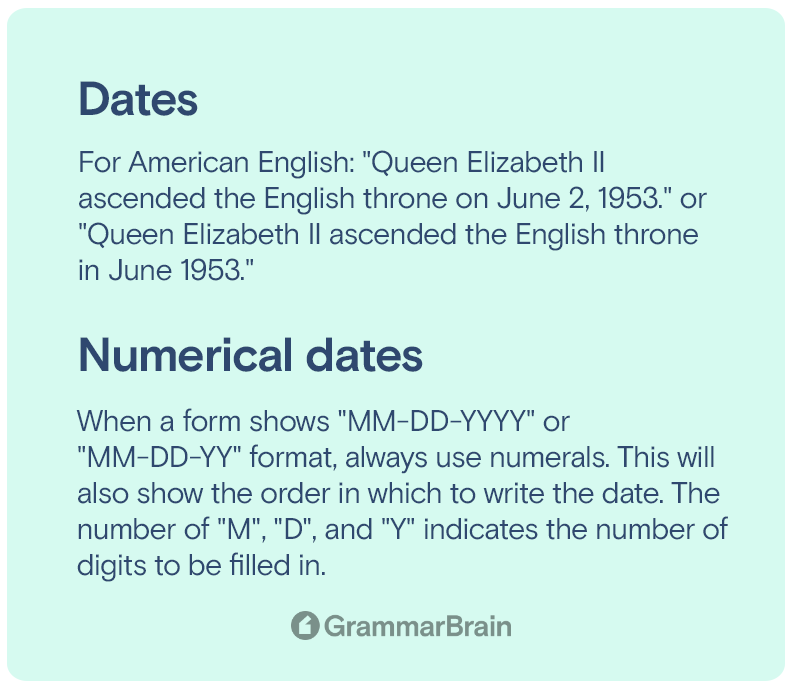
Should “in” or “on” be used when writing dates ?
When referring to an exact day, write the date using “on.” When referring to the year or the month, use “in.”
I am flying to New York on September 10, 2022.
The cafe will cease operations in September 2022.
How are dates written in technical or official documents?
When writing technical or official documents, always follow international standards rather than American or British English. This will make the document understandable to people belonging to different countries.
- Grammarly – How to Write Dates Correctly in English
- Cambridge dictionary – Dates
- The Editor’s Manual – Dates: How to Write Correctly
- LanguageTool – How to Write the Date
Inside this article
Fact checked: Content is rigorously reviewed by a team of qualified and experienced fact checkers. Fact checkers review articles for factual accuracy, relevance, and timeliness. Learn more.

About the author
Dalia Y.: Dalia is an English Major and linguistics expert with an additional degree in Psychology. Dalia has featured articles on Forbes, Inc, Fast Company, Grammarly, and many more. She covers English, ESL, and all things grammar on GrammarBrain.
Core lessons
- Abstract Noun
- Accusative Case
- Active Sentence
- Alliteration
- Adjective Clause
- Adjective Phrase
- Adverbial Clause
- Appositive Phrase
- Body Paragraph
- Compound Adjective
- Complex Sentence
- Compound Words
- Compound Predicate
- Common Noun
- Comparative Adjective
- Comparative and Superlative
- Compound Noun
- Compound Subject
- Compound Sentence
- Copular Verb
- Collective Noun
- Colloquialism
- Conciseness
- Conditional
- Concrete Noun
- Conjunction
- Conjugation
- Conditional Sentence
- Comma Splice
- Correlative Conjunction
- Coordinating Conjunction
- Coordinate Adjective
- Cumulative Adjective
- Dative Case
- Declarative Statement
- Direct Object Pronoun
- Direct Object
- Dangling Modifier
- Demonstrative Pronoun
- Demonstrative Adjective
- Direct Characterization
- Definite Article
- Doublespeak
- Equivocation Fallacy
- Future Perfect Progressive
- Future Simple
- Future Perfect Continuous
- Future Perfect
- First Conditional
- Gerund Phrase
- Genitive Case
- Helping Verb
- Irregular Adjective
- Irregular Verb
- Imperative Sentence
- Indefinite Article
- Intransitive Verb
- Introductory Phrase
- Indefinite Pronoun
- Indirect Characterization
- Interrogative Sentence
- Intensive Pronoun
- Inanimate Object
- Indefinite Tense
- Infinitive Phrase
- Interjection
- Intensifier
- Indicative Mood
- Juxtaposition
- Linking Verb
- Misplaced Modifier
- Nominative Case
- Noun Adjective
- Object Pronoun
- Object Complement
- Order of Adjectives
- Parallelism
- Prepositional Phrase
- Past Simple Tense
- Past Continuous Tense
- Past Perfect Tense
- Past Progressive Tense
- Present Simple Tense
- Present Perfect Tense
- Personal Pronoun
- Personification
- Persuasive Writing
- Parallel Structure
- Phrasal Verb
- Predicate Adjective
- Predicate Nominative
- Phonetic Language
- Plural Noun
- Punctuation
- Punctuation Marks
- Preposition
- Preposition of Place
- Parts of Speech
- Possessive Adjective
- Possessive Determiner
- Possessive Case
- Possessive Noun
- Proper Adjective
- Proper Noun
- Present Participle
- Quotation Marks
- Relative Pronoun
- Reflexive Pronoun
- Reciprocal Pronoun
- Subordinating Conjunction
- Simple Future Tense
- Stative Verb
- Subjunctive
- Subject Complement
- Subject of a Sentence
- Sentence Variety
- Second Conditional
- Superlative Adjective
- Slash Symbol
- Topic Sentence
- Types of Nouns
- Types of Sentences
- Uncountable Noun
- Vowels and Consonants
Popular lessons

Stay awhile. Your weekly dose of grammar and English fun.

The world's best online resource for learning English. Understand words, phrases, slang terms, and all other variations of the English language.
- Abbreviations
- Editorial Policy
- Link to facebook
- Link to linkedin
- Link to twitter
- Link to youtube
- Writing Tips
How to Write Dates Correctly

3-minute read
- 23rd October 2014
There are many different ways to write dates, so knowing which one to use in your work can be difficult. At a basic level, you need to get the format and information correct. But you also need to consider whether the style in which you’ve written the date is appropriate for your document.
Read on, then, for our guide on how to write dates correctly.
Writing Out the Date
In very formal writing, it’s often best to write out the date in full. The most formal version of this may include using an ordinal signifier (‘th’, ‘rd’ or ‘st’) after the date, like this:
The meeting is on the 23 rd of October 2016.
However, in most cases, you can just give a date, month and year:
The meeting is on 23 October 2016.
You would still pronounce this as ‘the 23 rd of October’ in speech, but in writing you can simplify this to make it easier to read.
Moreover, in some situations, you may want to include the day of the week in the date, especially if it has specific connotations (e.g. Friday the 13 th ).
Shorter Form Dates
In less formal writing, a shorter date format can be used. This typically uses only numbers separated by full stops or slashes, with no need to write out the name of the month. Shortening the year is also acceptable as long as it will be clear which year you mean, such as in the following:
You can also write out the date but shorten the month to save space:
- 14 January 2016 → 14 Jan 2016
- 9 October → 9 Oct
Although these options are easy to understand and perfectly acceptable in most writing, they are not typically correct in an academic context.
Find this useful?
Subscribe to our newsletter and get writing tips from our editors straight to your inbox.
Australian vs. American Dates
Another thing to keep in mind is that the date format is different in different places. In Australia , we use a day, month, year format, as shown above.
In America, the month comes first. As such, we can reformat some of the examples above to compare how they’d appear in Australia and America:
As you can see above, we’ve used a comma in the US dates to separate the day and the year, both of which are numbers.
The fact that the day and month are swapped around can lead to confusion, especially if written in number form, so do be aware of this!
The International Date Format
Finally, if you’re sharing information across the world, you may want to use the international date format (ISO 8601) . This is a standardised format that works across borders, so it is commonly used by government organizations and global businesses. And it always uses the format YYYY-MM-DD, which removes any chance of confusion:
We sent the invoice on 2020-07-10 .
The date above, for example, denotes the 10th of July 2020.
How to Write the Date in Academic Writing
There is no single ‘correct’ way to write the date in an essay, but it’s usually better to use a formal approach. Check your university style guide and see what it recommends. If it doesn’t specify a format, pick one you feel is appropriate and use it consistently throughout your document.
If you would like to have a 500-word sample of your work proofread for free, get in touch with the professionals at Proofed today!
Share this article:
Post A New Comment
Get help from a language expert. Try our proofreading services for free.
What is a content editor.
Are you interested in learning more about the role of a content editor and the...
4-minute read
The Benefits of Using an Online Proofreading Service
Proofreading is important to ensure your writing is clear and concise for your readers. Whether...
2-minute read
6 Online AI Presentation Maker Tools
Creating presentations can be time-consuming and frustrating. Trying to construct a visually appealing and informative...
What Is Market Research?
No matter your industry, conducting market research helps you keep up to date with shifting...
8 Press Release Distribution Services for Your Business
In a world where you need to stand out, press releases are key to being...
How to Get a Patent
In the United States, the US Patent and Trademarks Office issues patents. In the United...

Make sure your writing is the best it can be with our expert English proofreading and editing.
- Features for Creative Writers
- Features for Work
- Features for Higher Education
- Features for Teachers
- Features for Non-Native Speakers
- Learn Blog Grammar Guide Community Events FAQ
- Grammar Guide
How to Write the Date Correctly

Krystal N. Craiker
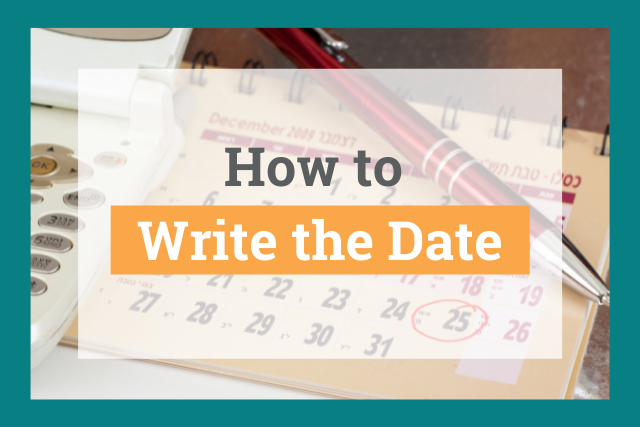
Writing dates can be confusing. Where do the commas go? What if you need to include the day of the week?
Today, we’re teaching you how to write the date correctly every time.
Most of this article will focus on the American date format, but we will cover the differences between British and American English date formats, too.
How to Write Dates
Correct date format in british english, how to write the date and time in a sentence, write dates consistently.
One reason writing dates is so confusing is that there are so many options.
How to write the date varies based on geography, the circumstance, such as how formal you need to be, whether you need the year, and whether you’re using purely numerical forms.
We’ve broken down the different date formats, so you know how to write the date in every situation.
Month-Day-Year
The month-day-year date is the most common format used in America.
When you need to write the entire date, place a comma after the day. Here’s what it looks like:
- July 4, 1776
When we see the date, we read the day in our heads, or out loud, as ordinal numbers. However, it’s not necessary to actually use ordinal numbers (e.g. 4th) when you write the day.
When you write the month-day-year format in the middle of a sentence, place another comma after the year.
- America was founded on July 4, 1776, when the Founding Fathers signed the Declaration of Independence.

Writing just the month and day is simple. Just leave off the comma and the year.
When you write the month-day format in the middle of a sentence, only place a comma after the day if the date ends a dependent clause or introductory phrase. Never place a comma after the month.
- We go every July 4 to see fireworks.
- Because it’s July 4, we are going to see fireworks.
Just like when you include the year, there’s no need to write the ordinal number form of the day.
The only time the date should include an ordinal number is when the format is inverted and the word “of” is included. Here’s an example from a famous folk song:
- I’m a Yankee Doodle Dandy! Yankee Doodle do-or-die. A real live nephew of my Uncle Sam, born on the 4th of July.
In this form, you can use numeric or word formats for the ordinal numbers: 4th or fourth.
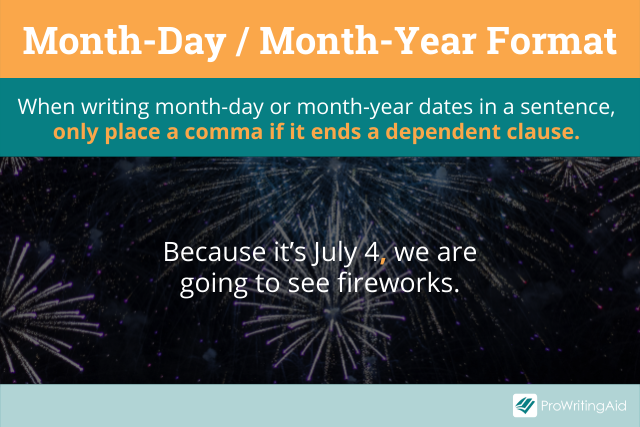
Sometimes, we only need to write dates with the month and year. We might refer to a general time frame, or we may not know the exact date of something.
As with other date formats, don’t include a comma between the month and year. Only place a comma after the year if the date ends a dependent clause or introductory phrase.
Let’s look at a few examples of how to write the month and year.
- Her baby is due in June 2022.
- In June 2022, she will have her baby.
With the Day of the Week
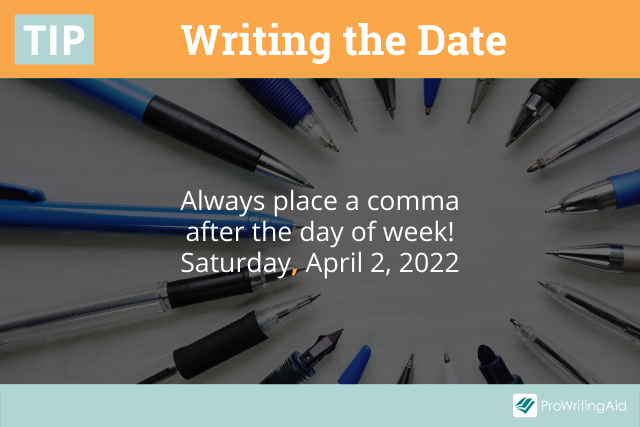
When writing dates with the day of the week, always place a comma between the day of the week and the rest of the date. Then, follow the above rules for the rest of the date.
This is one type of date format where the comma rule is the same for British English: you always put a comma after the day of the week.
Here are some examples of how to write the date with the day of the week. Please note these examples are using the American date format.
- Saturday, April 2, 2022
- The wedding is Saturday, April 2, 2022.
- The wedding takes place Saturday, April 2, 2022, at the Bellagio Chapel in Vegas.
Numerical Forms
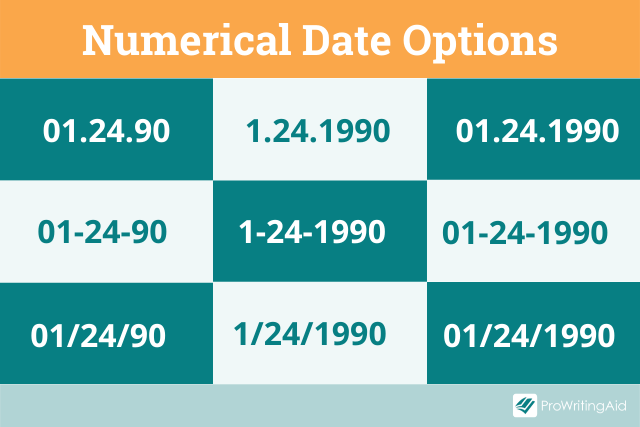
We don’t always write dates by spelling out the month. Often, we use an all-numeric date format, such as when we sign a form, take notes, or write in a diary.
Typically, we don’t use the purely numerical form when writing the date in a sentence. In those situations, use the rules above and spell out the month.
When you do write the date with just numbers, there are a few ways you can format it. However, you should always use the month-day-year format for American English.
There are a few accepted punctuation marks for numeric dates: hyphens , slashes , and periods . In American dates, hyphens and slashes are the most common.
It’s also acceptable to omit the zero in the month or day, if the number is less than 10. However, some online forms will require you to use a zero.
You can use either four digits or two digits for the year. Only use two-digit numbers if it’s clear which century you’re talking about.
If it’s a birthdate of a living person, we can deduce whether the year occurred in the 1900s or 2000s.
Now, let’s take a look at several ways we might write the same date in the numerical format.
Selecting one of these date formats is usually a matter of personal preference, although if you have a style guide for your writing, defer to its formatting.
The important thing is to be consistent with whichever format you choose.
Years, Decades, and Centuries
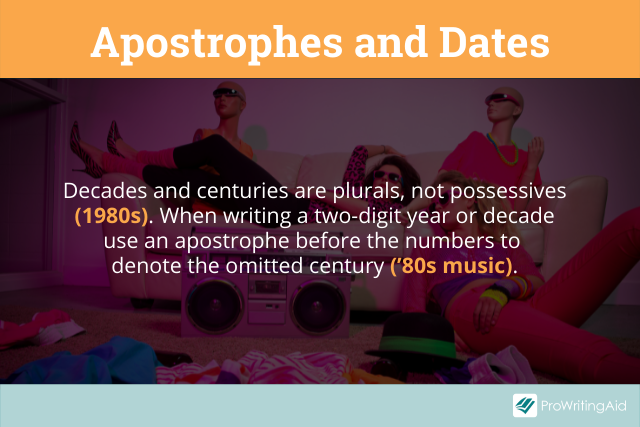
Years, decades, and centuries can be confusing to write. Let’s look at each type in more detail.
When we write the year, we typically use a four-digit format.
We saw in the previous section that we can use a two-digit year in the numeric form. Both four digits and two digits are correct and are a matter of personal preference.
But sometimes we reference a year in a sentence and only use two-digits. In this case, we place an apostrophe before the digits. The apostrophe replaces the century of a four-digit year.
- I bought a ’69 Camaro.
We don’t always use a two-digit format in a sentence. You could say, “I bought a 1969 Camaro.” But when you choose to use only two-digits in a sentence, the apostrophe is required.
Remember, the apostrophe is not required when you write an entire, exact date in numerical form.
When we write years out in long form, you can include “and” after “thousand,” or you can omit it. American English tends to omit the “and,” but it's correct either way.
- Correct: Two thousand eight was when I graduated high school.
- Correct: Two thousand and eight was when I graduated high school.
Apostrophe rules get tricky when we write decades. When we reference a decade, the rules for writing plurals apply: never use apostrophes for plural words. For decades, never put an apostrophe between the decade and the /s/.
- Incorrect: I love listening to the hair bands of the 1980’s.
- Correct: I love listening to the hair bands of the 1980s.
If you omit the first two digits, place an apostrophe before the decade number. You still shouldn’t put an apostrophe before the /s/.
- Incorrect: I love listening to the hair bands of the 80’s.
- Incorrect: I love listening to the hair bands of the ’80’s.
- Correct: I love listening to the hair bands of the ’80s.
You can also write the decade in word form, e.g. “eighties.”
Similarly to decades, if you reference a century in a four-digit format, do not place an apostrophe before the /s/.
- Incorrect: I love the fashion of 1700’s.
- Correct: I love the fashion of the 1700s.
Adding an apostrophe to plurals is a common writing error. ProWritingAid will point out unnecessary apostrophes in your plural numbers.
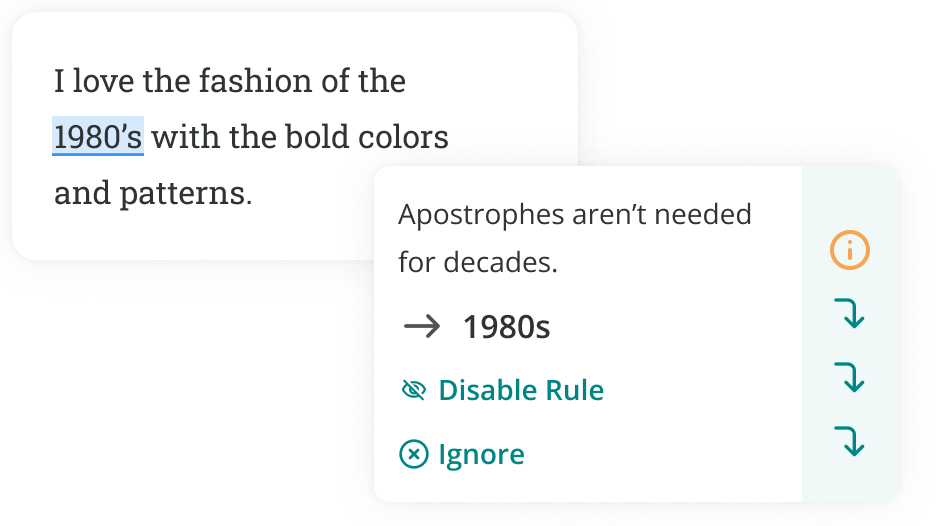
When you write centuries in the ordinal form, add the correct suffix after the number or use the word format. There’s no need to capitalize the word form.
- Correct: I love 18th-century fashion.
- Correct: I love eighteenth-century fashion.

British English uses a different date format in which the month and day are inverted (day-month-year). In British English, dates do not need commas before or after the year, even in a sentence.
- 11 November 1918
- Armistice Day on 11 November 1918 marked the end of World War I.
The inverted format also applies to numeric dates, e.g. 14/2/2017.
We’ve seen several examples of how to write the date in a sentence. Writing the time in a sentence is simple.
You can write the time in a sentence as hour:minute plus a.m. or p.m. If you’re using a 24-hour time format, the a.m. or p.m. is not required.
You can also leave it off if it’s clear what time of day something occurs. Here’s what this looks like:
- I get out of school at 3:45 p.m.
- I get out of school at 3:45. (The p.m. is not necessary because we can assume you don’t get out of school at 3:45 a.m.)
- I get out of school at 15:45.
If the time that you’re writing occurs on the hour, you can also write “o’clock.” Instead of a.m. or p.m., describe the time of day if necessary.
- He will be there at four o’clock.
- He will be there at four o’clock in the afternoon.
If you need to write both the time and date, just combine the rules. Here are two examples:
- My flight arrives on December 13 at 10:40 a.m.
- Your appointment is at 2 o’clock on February 27, 2022.
There are many ways to write a date, but it’s important to use the same format consistently throughout your writing.
ProWritingAid’s Consistency Report can check for consistent mechanics, like dates, punctuation, spelling variations, and more.
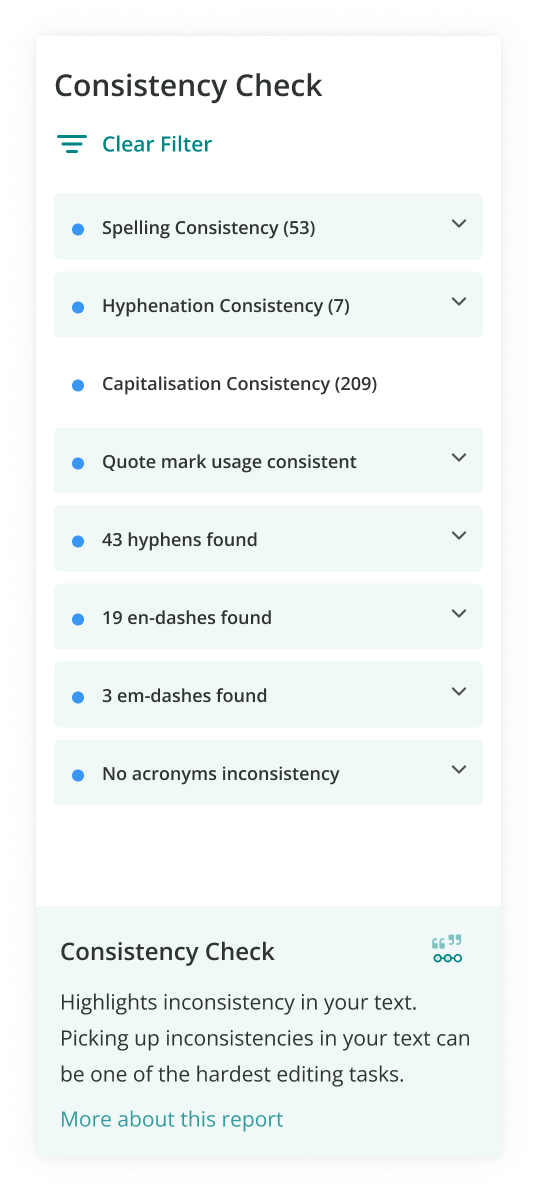
Take your writing to the next level:

20 Editing Tips from Professional Writers
Whether you are writing a novel, essay, article, or email, good writing is an essential part of communicating your ideas., this guide contains the 20 most important writing tips and techniques from a wide range of professional writers..

Be confident about grammar
Check every email, essay, or story for grammar mistakes. Fix them before you press send.
Krystal N. Craiker is the Writing Pirate, an indie romance author and blog manager at ProWritingAid. She sails the seven internet seas, breaking tropes and bending genres. She has a background in anthropology and education, which brings fresh perspectives to her romance novels. When she’s not daydreaming about her next book or article, you can find her cooking gourmet gluten-free cuisine, laughing at memes, and playing board games. Krystal lives in Dallas, Texas with her husband, child, and basset hound.
Get started with ProWritingAid
Drop us a line or let's stay in touch via :
The Editor’s Manual
Free learning resource on English grammar, punctuation, usage, and style.
How to Write Dates

To write the exact date, spell out the month, and write the day and the year in numerals. The American date format is month-day-year, with a comma between day and year ( May 1, 2022) , while the British format is day-month-year, with no comma between month and year ( 1 May 2022 ). Don’t use ordinal numbers in dates in formal texts ( May 1 st , 2022 ). You may also show the day of the week ( Sunday, May 1, 2022 ).
If only the month and year are shown, don’t insert a comma between the two ( May 2022 ). To specify the day alone, write it as an ordinal number ( We arrive on the first ).
![how to write a date an essay Graphic titled "How to Write Dates." The left panel shows an illustration of two people marking the date on a gigantic calendar. The right panel lists the following rules and examples. Spell out the month. Use numerals for day and year (“American: December 16, 2021”; “British: 16 December 2021”). Don’t place a comma between month and year (“Poor: We met in December, 2021”; “Better: We met in December 2021”). Write the day as an ordinal when it stands alone (“They left on the sixteenth [or 16th]”).](https://editorsmanual.com/wp-content/uploads/2022/11/dates-2-media-1024x576.webp)
Date: Month, day, and year
The American date format is month-day-year. In running text, spell out the month, and write the day and year in numerals. Use commas to separate day and year. Don’t use ordinals ( st , nd , rd , th ).
- The Declaration of Independence was issued on July 4, 1776 .
- They were married on October 25, 2019, on a beach in the Maldives.
- On January 20, 2021, Joe Biden became president of the United States.
To set off the year, use commas in pairs: a comma must appear not just before but also after the year.
- Incorrect: It was on August 14, 1945 that an armistice was finally declared. Correct: It was on August 14, 1945, that an armistice was finally declared.
The British date format is day-month-year. The day and year are written in numerals, and the month is spelled out. No comma is needed between month and year. This system is also followed in much of Europe and the rest of the world.
- On 15 August 1947 , India gained independence from Britain.
- The Channel Tunnel opened on 6 May 1992 , linking London and Paris by rail.
- The UK left the EU on 31 January 2020 .
Date: Month and year
When only month and year are specified, the month appears before the year. No comma is needed between the two.
- Twitter was founded in March 2006 and launched later that year.
- In January 2020 , reports of a new respiratory virus emerged from China.
- Farley first lost the lottery in November 1997 .
The preposition “of” between month and year is unnecessary and omitted in formal writing.
- This report was originally published in May of 2015 .
Date: Day and month
When it is clear which year is being referred to, you may indicate only day and month. Spell out the month, and write the day in numerals. Remember that day follows month in American usage. Don’t use ordinal numbers ( st , nd , rd , th ).
- Her birthday is November 23 .
- The last day to submit your applications is February 10 .
- On May 11 this year, our astronauts landed on Venus.
In British and other European writing, the day appears before the month.
- My daughter was born on 23 November last year.
- The deadline is 10 February .
- On 11 May this year, our astronauts landed on Mars.
The use of ordinal numbers ( st , nd , rd , th ) in dates is unnecessary. Avoid it in formal writing.
- Poor: The Durandians landed on July 19th at 3 p.m. Better: The Durandians landed on July 19 at 3 p.m.
In creative and other informal writing, the day and the month are often shown in words.
- They were married on the nineteenth of September last year.
Date: The day alone
When only the day is mentioned, spell out single-digit numbers. Two-digit days may be either spelled out or written in numerals. Use ordinal numbers ( st , nd , rd , th ).
- We woke up early on the morning of the fifth .
- We’ll reach on the sixteenth ( or the 16th ).
Style guides differ in their recommendations on whether to write numbers in numerals or words. Numbers under 10 are generally spelled out. The Chicago Manual of Style recommends spelling out two-digit numbers as well, while the AP Stylebook and APA Publication Manual suggest using figures for numbers from 10 onward.
When using figures, don’t set the ordinal in superscript (16th, not 16 th ).
Date with day of the week
To show a day of the week alongside a date, write the day followed by a comma, and then write the date. This can be helpful in appointments and invitations.
- American: The apocalypse was expected to happen on Saturday, May 21, 2011 .
- British: The conference starts on Monday, 8 August 2022 .
The date in numerals
Dates may be written in all numerals . A numeric date format is used when the date is standalone—for example, in a signature. The U.S. date format is month-day-year, while the day-month-year format is followed by the UK and other nations. Slashes or hyphens are used to separate the parts of the date.
- American : Signed 5-11-21 for May 11, 2021 British: Signed 11-5-21 for 11 May 2021
- American: Dated 11/5/2021 for November 5, 2021 British: Dated 5/11/2021 for 5 November 2021
All-numeric dates are also written in the YYYY-MM-DD format, as specified by the ISO . This internationally agreed way to show dates is common in government, corporate, and other official usage. One of the benefits of this system is that it makes for easier sorting and storage of files and folders. In file names and data entries, hyphens are generally omitted.
- Please submit all applications by 2023-05-01 . referring to May 1, 2023
- Application_ 20230501 date in a file name
The date in words
Dates are generally written in words rather than numerals in creative writing and legal documents. Spell out the day and the month, but use numerals for the year.
- Where were you on the night of the fifteenth at 11 p.m.?
- On the twenty-second of January 2021 , an object landed in Farley’s garden.
- They left on the first of December .
In formal writing, follow the prescribed format of writing the day and year in figures and spelling out the month.
- American: On January 22, 2021, an object landed in Farley’s garden. British: On 22 January 2021 , an object landed in Farley’s garden.
- American: They left on December 1 . British: They left on 1 December .
The month abbreviated
When part of a specific date, the month may be abbreviated . Write the first three letters of the month, followed by a period . Don’t abbreviate May, June, and July. In formal writing, abbreviations for dates are useful in tables and charts but avoided in running text.
- Jan. 9, 1997
- Feb. 24, 2022
- May 1, 1997
In British style, the form is day-month-year.
- 9 Jan. 1997
- 24 Feb. 2022
In AP style, the abbreviations Jan. , Feb. , Aug. , Sept. , Oct. , Nov. , and Dec. are used. The remaining months are not abbreviated.
Periods may be omitted in informal usage, if there are space constraints, or in a fixed format, such as a table. The months June and July are also then abbreviated.
- Jan 9, 2021
- Jun 11, 2023
- 11-Jun-2023
- 29 Dec 2051
On vs. in with dates
Use on with a date with the exact day. Use in to refer to the month or the year.
- Your flight departs on August 3, 2022 .
- Your flight departs on the third of August .
- The restaurant will reopen in August 2022 .
- The restaurant will reopen in August .
- The restaurant will reopen in 2022 .
Share this article
Place a comma between the day and the year in a date.
No comma is necessary between the month and the year in a date.
No comma is needed between the month and the year in a date.
Ordinals are not used in dates in formal writing.
- AI in action
- AI in the enterprise
- Humans of AI
Words at work
- Inside Writer
- Content strategy
- Inspiration
– 4 min read

How to write dates perfectly

Jessica Malnik
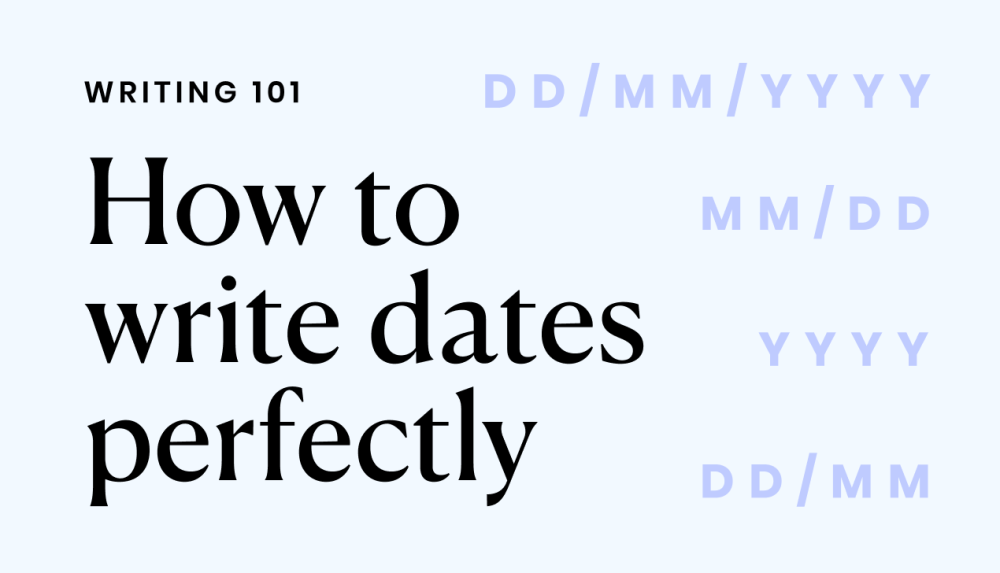
Writing dates can feel stressful because the rules and guidelines vary not just between US English or British English, but also depending on your preferred style guide .
In this post, we share general guidelines to help you write dates perfectly every time.
Note: Before we dive in, we’ll focus on how to write dates in US English.
How to write dates in US English correctly
As a general guide, dates are typically written in the order of month – day – year in US English. Here are the general rules and examples when using dates in your writing.
How to write the year
The year is typically written as numerals in US English. An exception is if you start your sentence with the year. In that situation, you should write out the year in words.
Note: When writing the year in words, you generally don’t write and after thousand when discussing a year after 2000 in US English.
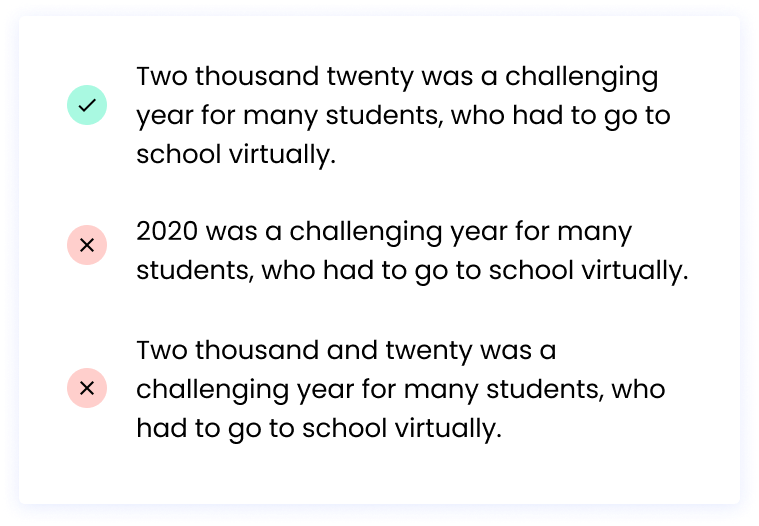
How to write months and days
There are different formats you can select when writing the months and days, depending on your needs. When writing the month and day, you put the month before the date and use cardinal numbers (1, 2, 3, 4…) instead of ordinal numbers (1st, 2nd, 3rd, 4th…).
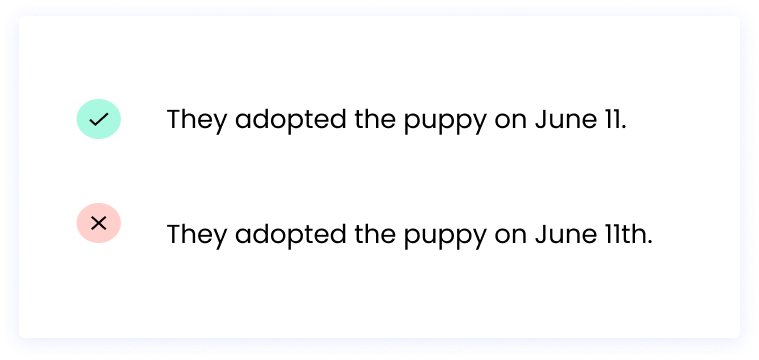
If you want to write the date using the month, day, and year, you’ll use cardinal numbers for the day. You’ll also need a comma between the day and year. In US English, the month comes before the day, and the year comes after the day.
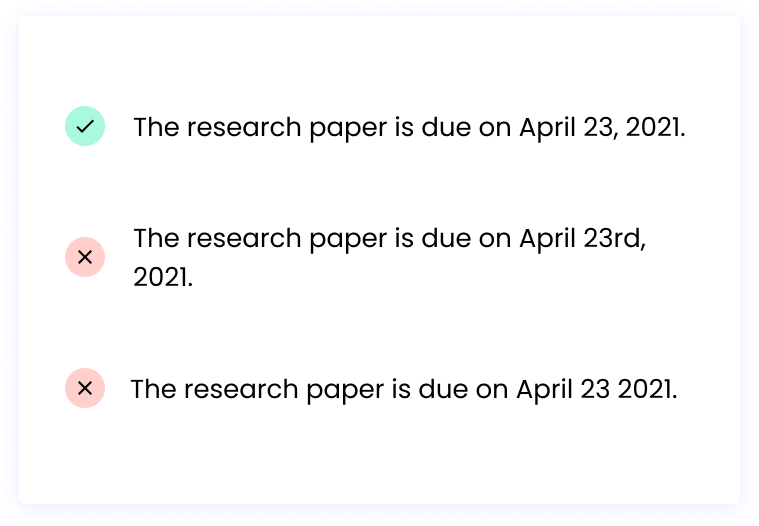
You can use ordinal numbers if you’re writing the date using of or writing the day without including the month.

How to write dates with days of the week
You’ll write the day of the week before the rest of the date when you want to include the day of the week. You’ll need to place a comma after the day of the week to separate it from the rest of the date.
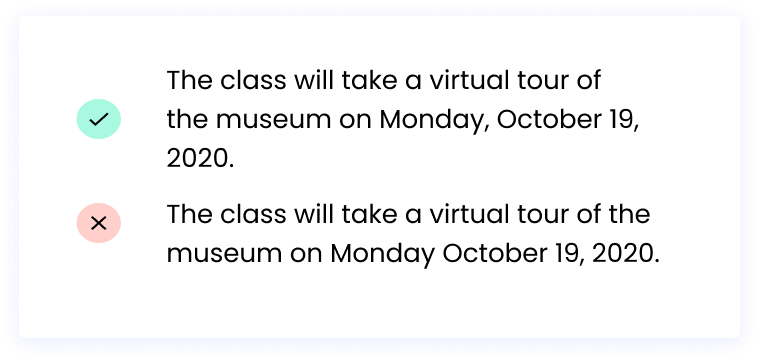
How to write dates as decades and centuries
When writing the date as a decade or century, you can write it numerically or in words.
When writing decades numerically, you can write them as two-digit numbers with an apostrophe before the numbers and an “-s” after the numbers. You do this because when the decade is in a two-digit form, it’s both an abbreviation and plural.
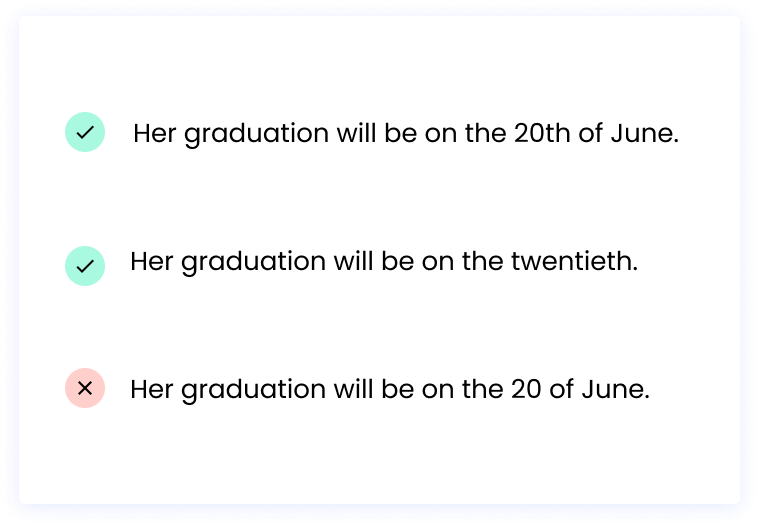
The decade can also be written as four-digit numbers with an “-s” after the numbers, like this: 1990s. However, if you don’t include the “-s,” the reader may think you’re referring to that year instead of the whole decade.
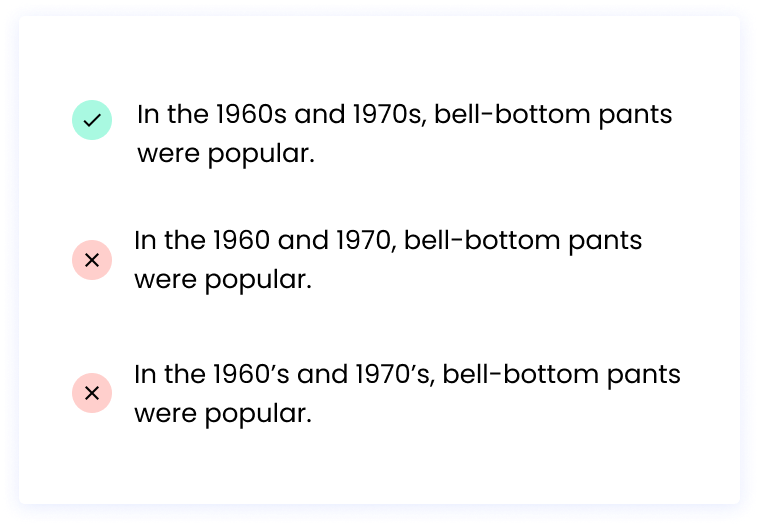
When writing centuries numerically, you don’t use an apostrophe before the “-s” since centuries are plural and not possessive.
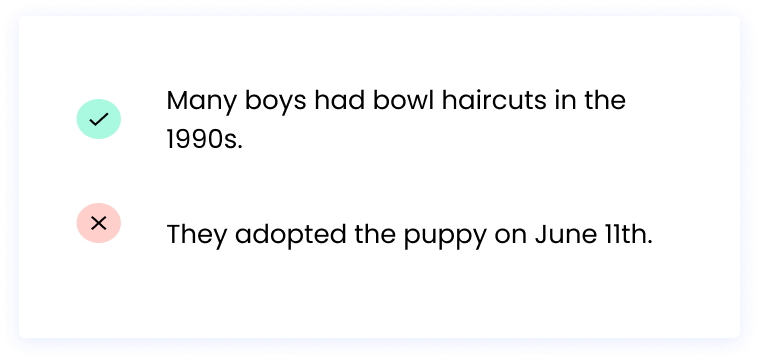
As with decades, you can also write out the century in words, such as the nineteenth century . Centuries are typically lowercase, unless it starts the sentence or is used in a title.
How to write dates in essays and papers
When writing dates in essays and papers, you want to follow the rules indicated by the style guide you’re asked to follow, such as AP Stylebook , Chicago Manual of Style, The Cambridge Guide to English Usage, etc.
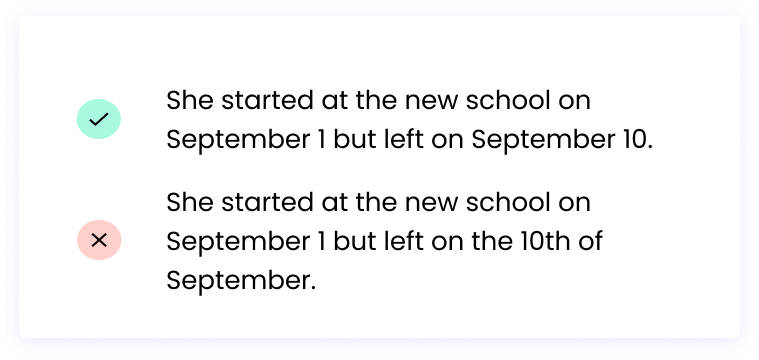
If you’re writing a formal paper, you’ll typically want to avoid abbreviations. If you choose to abbreviate part of the date, make sure the reader can understand the date based on the context clues. For instance, if you abbreviate the decade as the ’40s, it should be clear whether you mean the 1940s, the 1840s, and so on.
How to write dates in British English
When writing dates in British English, a lot of the rules are the same. However, there are a few key differences, including:
- Dates are typically written in the order of day – month – year in British English.
- When you’re writing the year in words, in British English, you write and after thousand when discussing a year after 2000.
- If you’re adding the day of the week to the date, it comes before the date. You should separate the name of the day from the date by using a comma or by using the and of .
While there are different rules and styles to writing dates, the process doesn’t have to be difficult. To help guide you, determine your primary audience, whether you need to follow a particular style guide, and write the dates consistently throughout. When writing, you’ll also want to make sure that any abbreviations make sense within the context of your paper. If there could be any confusion, you’ll want to avoid using abbreviations.
Concerned about writing dates incorrectly? Try Writer! Start a free trial and set your preferred format for short dates, long dates, and more.
--> “A wide screen just makes a bad film twice as bad.” -->
May Habib CEO, Writer.com
Here’s what else you should know about Ascending.
More resources
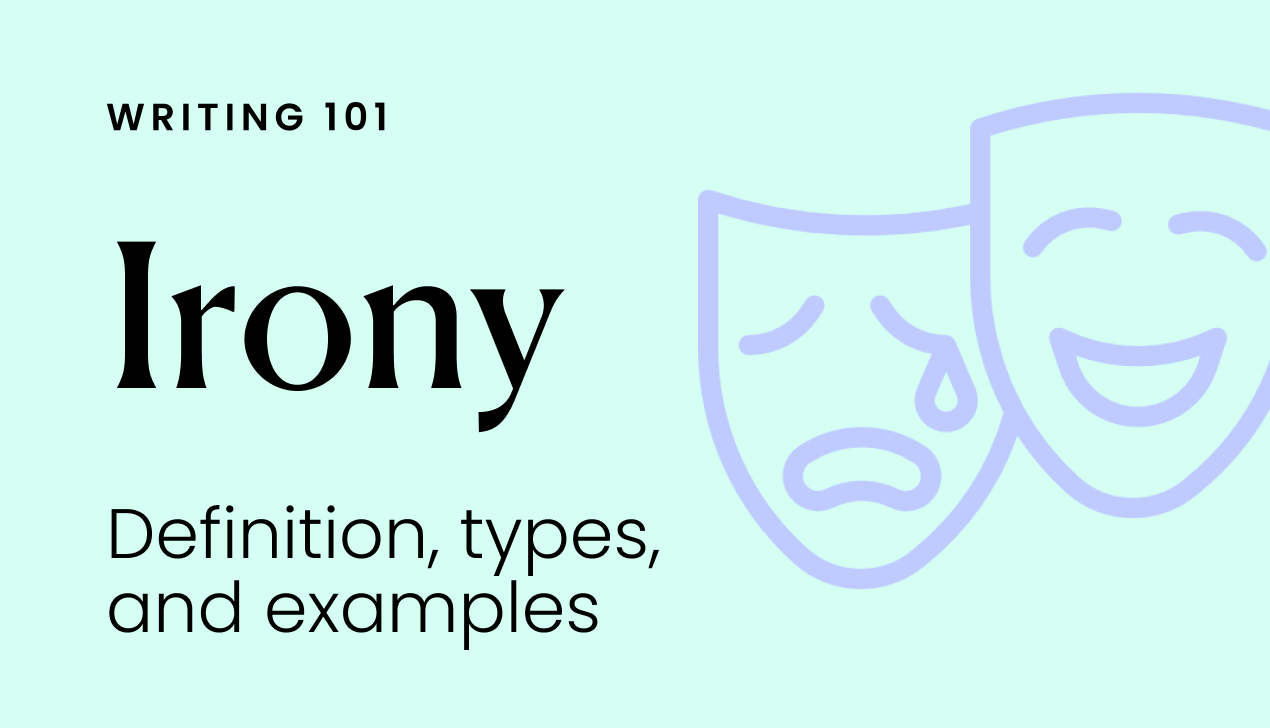
– 10 min read
Irony: definition, types, and examples

Holly Stanley
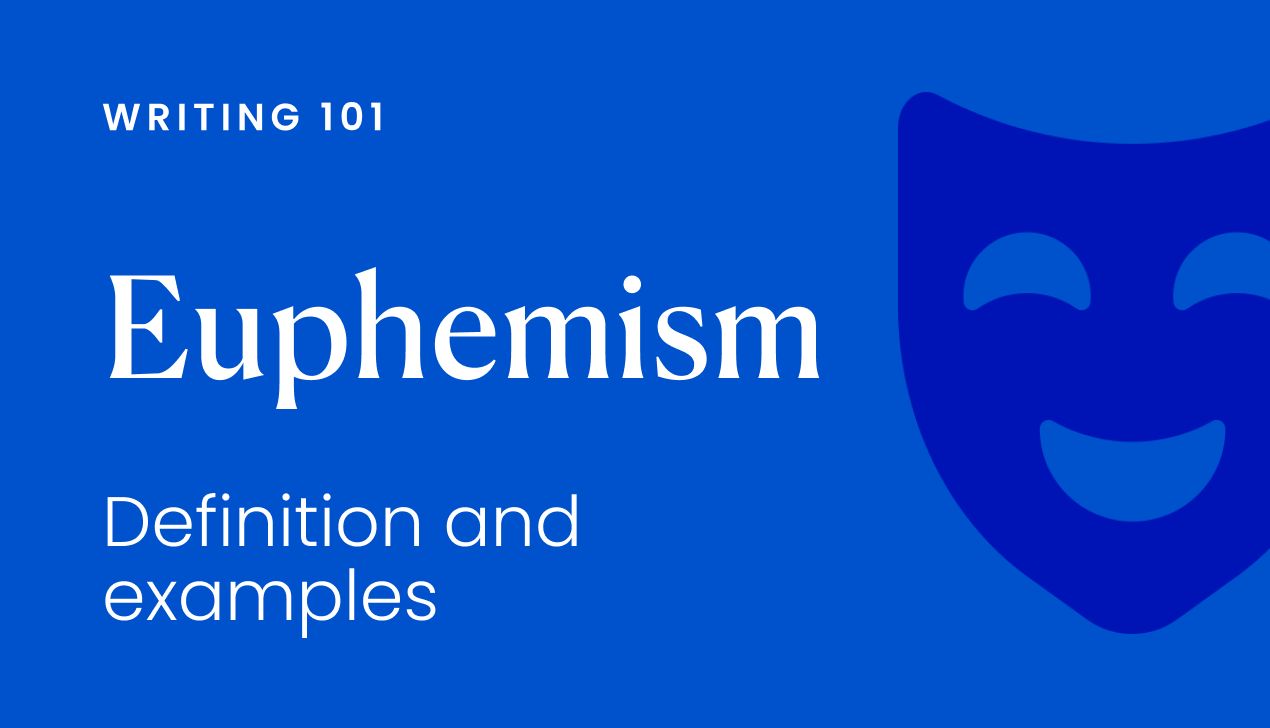
– 5 min read
Euphemism: definition and examples

Masooma Memon

– 9 min read
What content marketers can learn from a wig-wearing Texas funk trio

Jamie Wallace

- In-depth Dissertation Proofreading & Editing Service
- Advanced Essay Proofreading Service
- Paraphrasing Services
- Journal Article Proofreading & Editing
- Text Reduction Service
- Proofreading Research Proposals
- Thesis & Dissertation Formatting
- Practical tips on dissertation writing
- Writing a thesis abstract
- Writing a thesis statement
- Book Proofreading Service
- Book Editing Service
- Business Proofreading Service
- Business Editing Service
- Business Substantive Copy-editing
- Legal Proofreading Services
- Proofreading Services for Freelance Journalists
- Copyediting & Proofreading Services for Professionals
- Proofreading Services for PR & Marketing Firms
- Proofreading & Editing for Translation Companies
- Text proofreading process
- Writing a good essay
- Business proofreading
- Formal/informal English
- How to use et al.
- Four types of academic writing
- First vs Third Person In Academic Writing
- Useful links
- Our proofreaders/editors
- Why trust us?
- English language blog
How to write dates in academic manuscripts
Dates in ma & phd dissertations/theses.
Authors of academic papers such as theses, dissertations, peer-reviewed journal articles sometimes need to mention dates in their manuscripts.
Dates have to be written according to convention and specific rules. How a date is written in American English is different from how it is written in British English.
Indeed, within British English itself dates can be written in more than one format.
It is quite important to write dates correctly in your academic papers.
Let's delve into how dates should be used or written in academic texts – with some illustrative examples:
15 May 2022
May 15, 2022
Sunday, May 15, 2022
Sunday, 15 May 2022
15/05.22
When writing the date in an essay, thesis, or other academic document, the date format depends on whether it is written in American, Australian, or British English. Secondly, it is helpful to consult a style guide provided by the academic institution. Thirdly, consistency is essential whichever format is chosen.
Date format in American English
The format in American English is month-date-year, and a comma should be inserted between the date and year; for example, May 15, 2022. The date may also be expressed in figures such as 05/15/22 or 05/15/2022. Where the day of the week is used, the format should be Sunday, May 25, 2022.
Date format in British English
In British English, the format is date-month-year, and no comma is used; for example, 15 May 2022. The date may also be written in figures such as 15/05/22 or 15/05/2022. Where the day of the week is used, the format should be Sunday, 8 May 2022. Note that in this case, a comma is used after the day of the week.
Date format in Australian English
Australian English tends to follow British English when expressing the date in a dissertation, journal article or other academic document. The main difference in Australian English is that the day of the week is included in all official documents in the format Sunday, 15 May 2022. In newspapers the format is Sunday, May 15, 2022.
Some comments on all formats
It is not usual to use ordinals (15 th May) in essays and other academic documents. However, if they are used, it should be in the format fifteenth of May. In some cases, it is not always necessary to write the year. Consider the sentence, ‘It was decided that the experiment would be conducted in 2021, and it was performed on March 20.’ Here it is obvious that March 20 is in 2021. Similarly, it is not always necessary to repeat the month; For example, in the sentence, ‘The university examinations are always held in June, and this year they will begin on the eighth.’
Style guides
Most academic institutions provide a style guide. This should always be consulted before the thesis or essay is written. The style guide will specify whether the date format is to be in British, American, or Australian English, and whether it is to be in words (15 May 2022) or in figures (15/05/22). It may also state if abbreviations are to be used for months (such as, Jan, Feb). However, in all cases, the months of May, June, and July are not abbreviated. The reader, as well as the writer, needs to be aware of whether British or American format is being used, otherwise the date could be misread, thereby causing confusion. For example, in British English 04/03/22 means 04 March 2022, while in American English it means April 04, 2022.
Consistency
As stated above, there is a considerable variety of formats for dates in academic documents. The choice of which format to use depends on whether the document is in American/Australian/British English and the requirements of the style guide, while personal preference may also be a factor. Nevertheless, whichever format is chosen, consistency is vital. A lack of consistency (such as use of British English for one date and American for another) will undoubtedly cause confusion and result in incorrect dates.
Are you looking for a professional editor to proofread your dissertation, thesis, essay or any other academic manuscript? We - at the Ultimate Proofreader - provide fully customisable proofreading services . As a dissertation proofreading and editing service provider, we help students in the UK achieve the outcome of their post-graduate studies.
Purdue Online Writing Lab Purdue OWL® College of Liberal Arts
MLA General Format

Welcome to the Purdue OWL
This page is brought to you by the OWL at Purdue University. When printing this page, you must include the entire legal notice.
Copyright ©1995-2018 by The Writing Lab & The OWL at Purdue and Purdue University. All rights reserved. This material may not be published, reproduced, broadcast, rewritten, or redistributed without permission. Use of this site constitutes acceptance of our terms and conditions of fair use.
MLA Style specifies guidelines for formatting manuscripts and citing research in writing. MLA Style also provides writers with a system for referencing their sources through parenthetical citation in their essays and Works Cited pages.
Writers who properly use MLA also build their credibility by demonstrating accountability to their source material. Most importantly, the use of MLA style can protect writers from accusations of plagiarism, which is the purposeful or accidental uncredited use of source material produced by other writers.
If you are asked to use MLA format, be sure to consult the MLA Handbook (9th edition). Publishing scholars and graduate students should also consult the MLA Style Manual and Guide to Scholarly Publishing (3rd edition). The MLA Handbook is available in most writing centers and reference libraries. It is also widely available in bookstores, libraries, and at the MLA web site. See the Additional Resources section of this page for a list of helpful books and sites about using MLA Style.
Paper Format
The preparation of papers and manuscripts in MLA Style is covered in part four of the MLA Style Manual . Below are some basic guidelines for formatting a paper in MLA Style :
General Guidelines
- Type your paper on a computer and print it out on standard, white 8.5 x 11-inch paper.
- Double-space the text of your paper and use a legible font (e.g. Times New Roman). Whatever font you choose, MLA recommends that the regular and italics type styles contrast enough that they are each distinct from one another. The font size should be 12 pt.
- Leave only one space after periods or other punctuation marks (unless otherwise prompted by your instructor).
- Set the margins of your document to 1 inch on all sides.
- Indent the first line of each paragraph one half-inch from the left margin. MLA recommends that you use the “Tab” key as opposed to pushing the space bar five times.
- Create a header that numbers all pages consecutively in the upper right-hand corner, one-half inch from the top and flush with the right margin. (Note: Your instructor may ask that you omit the number on your first page. Always follow your instructor's guidelines.)
- Use italics throughout your essay to indicate the titles of longer works and, only when absolutely necessary, provide emphasis.
- If you have any endnotes, include them on a separate page before your Works Cited page. Entitle the section Notes (centered, unformatted).
Formatting the First Page of Your Paper
- Do not make a title page for your paper unless specifically requested or the paper is assigned as a group project. In the case of a group project, list all names of the contributors, giving each name its own line in the header, followed by the remaining MLA header requirements as described below. Format the remainder of the page as requested by the instructor.
- In the upper left-hand corner of the first page, list your name, your instructor's name, the course, and the date. Again, be sure to use double-spaced text.
- Double space again and center the title. Do not underline, italicize, or place your title in quotation marks. Write the title in Title Case (standard capitalization), not in all capital letters.
- Use quotation marks and/or italics when referring to other works in your title, just as you would in your text. For example: Fear and Loathing in Las Vegas as Morality Play; Human Weariness in "After Apple Picking"
- Double space between the title and the first line of the text.
- Create a header in the upper right-hand corner that includes your last name, followed by a space with a page number. Number all pages consecutively with Arabic numerals (1, 2, 3, 4, etc.), one-half inch from the top and flush with the right margin. (Note: Your instructor or other readers may ask that you omit the last name/page number header on your first page. Always follow instructor guidelines.)
Here is a sample of the first page of a paper in MLA style:

The First Page of an MLA Paper
Section Headings
Writers sometimes use section headings to improve a document’s readability. These sections may include individual chapters or other named parts of a book or essay.
MLA recommends that when dividing an essay into sections you number those sections with an Arabic number and a period followed by a space and the section name.
MLA does not have a prescribed system of headings for books (for more information on headings, please see page 146 in the MLA Style Manual and Guide to Scholarly Publishing , 3rd edition). If you are only using one level of headings, meaning that all of the sections are distinct and parallel and have no additional sections that fit within them, MLA recommends that these sections resemble one another grammatically. For instance, if your headings are typically short phrases, make all of the headings short phrases (and not, for example, full sentences). Otherwise, the formatting is up to you. It should, however, be consistent throughout the document.
If you employ multiple levels of headings (some of your sections have sections within sections), you may want to provide a key of your chosen level headings and their formatting to your instructor or editor.
Sample Section Headings
The following sample headings are meant to be used only as a reference. You may employ whatever system of formatting that works best for you so long as it remains consistent throughout the document.
Formatted, unnumbered:
Level 1 Heading: bold, flush left
Level 2 Heading: italics, flush left
Level 3 Heading: centered, bold
Level 4 Heading: centered, italics
Level 5 Heading: underlined, flush left
- PRO Courses Guides New Tech Help Pro Expert Videos About wikiHow Pro Upgrade Sign In
- EDIT Edit this Article
- EXPLORE Tech Help Pro About Us Random Article Quizzes Request a New Article Community Dashboard This Or That Game Popular Categories Arts and Entertainment Artwork Books Movies Computers and Electronics Computers Phone Skills Technology Hacks Health Men's Health Mental Health Women's Health Relationships Dating Love Relationship Issues Hobbies and Crafts Crafts Drawing Games Education & Communication Communication Skills Personal Development Studying Personal Care and Style Fashion Hair Care Personal Hygiene Youth Personal Care School Stuff Dating All Categories Arts and Entertainment Finance and Business Home and Garden Relationship Quizzes Cars & Other Vehicles Food and Entertaining Personal Care and Style Sports and Fitness Computers and Electronics Health Pets and Animals Travel Education & Communication Hobbies and Crafts Philosophy and Religion Work World Family Life Holidays and Traditions Relationships Youth
- Browse Articles
- Learn Something New
- Quizzes Hot
- This Or That Game New
- Train Your Brain
- Explore More
- Support wikiHow
- About wikiHow
- Log in / Sign up
- Education and Communications
- College University and Postgraduate
- Academic Writing
How to Write an Essay
Last Updated: April 2, 2024 Fact Checked
This article was co-authored by Christopher Taylor, PhD and by wikiHow staff writer, Megaera Lorenz, PhD . Christopher Taylor is an Adjunct Assistant Professor of English at Austin Community College in Texas. He received his PhD in English Literature and Medieval Studies from the University of Texas at Austin in 2014. There are 18 references cited in this article, which can be found at the bottom of the page. This article has been fact-checked, ensuring the accuracy of any cited facts and confirming the authority of its sources. This article has been viewed 7,929,327 times.
An essay is a common type of academic writing that you'll likely be asked to do in multiple classes. Before you start writing your essay, make sure you understand the details of the assignment so that you know how to approach the essay and what your focus should be. Once you've chosen a topic, do some research and narrow down the main argument(s) you'd like to make. From there, you'll need to write an outline and flesh out your essay, which should consist of an introduction, body, and conclusion. After your essay is drafted, spend some time revising it to ensure your writing is as strong as possible.
Understanding Your Assignment

- The compare/contrast essay , which focuses on analyzing the similarities and differences between 2 things, such as ideas, people, events, places, or works of art.
- The narrative essay , which tells a story.
- The argumentative essay , in which the writer uses evidence and examples to convince the reader of their point of view.
- The critical or analytical essay, which examines something (such as a text or work of art) in detail. This type of essay may attempt to answer specific questions about the subject or focus more generally on its meaning.
- The informative essay , that educates the reader about a topic.

- How long your essay should be
- Which citation style to use
- Formatting requirements, such as margin size , line spacing, and font size and type
Christopher Taylor, PhD
Christopher Taylor, Professor of English, tells us: "Most essays will contain an introduction, a body or discussion portion, and a conclusion. When assigned a college essay, make sure to check the specific structural conventions related to your essay genre , your field of study, and your professor's expectations."

- If you're doing a research-based essay , you might find some inspiration from reading through some of the major sources on the subject.
- For a critical essay, you might choose to focus on a particular theme in the work you're discussing, or analyze the meaning of a specific passage.

- If you're having trouble narrowing down your topic, your instructor might be able to provide guidance or inspiration.
Planning and Organizing Your Essay

- Academic books and journals tend to be good sources of information. In addition to print sources, you may be able to find reliable information in scholarly databases such as JSTOR and Google Scholar.
- You can also look for primary source documents, such as letters, eyewitness accounts, and photographs.
- Always evaluate your sources critically. Even research papers by reputable academics can contain hidden biases, outdated information, and simple errors or faulty logic.
Tip: In general, Wikipedia articles are not considered appropriate sources for academic writing. However, you may be able to find useful sources in the “References” section at the end of the article.

- You might find it helpful to write your notes down on individual note cards or enter them into a text document on your computer so you can easily copy, paste , and rearrange them however you like.
- Try organizing your notes into different categories so you can identify specific ideas you'd like to focus on. For example, if you're analyzing a short story , you might put all your notes on a particular theme or character together.

- For example, if your essay is about the factors that led to the end of the Bronze Age in the ancient Middle East, you might focus on the question, “What role did natural disasters play in the collapse of Late Bronze Age society?”

- One easy way to come up with a thesis statement is to briefly answer the main question you would like to address.
- For example, if the question is “What role did natural disasters play in the collapse of Late Bronze Age society?” then your thesis might be, “Natural disasters during the Late Bronze Age destabilized local economies across the region. This set in motion a series of mass migrations of different peoples, creating widespread conflict that contributed to the collapse of several major Bronze Age political centers.”

- When you write the outline, think about how you would like to organize your essay. For example, you might start with your strongest arguments and then move to the weakest ones. Or, you could begin with a general overview of the source you're analyzing and then move on to addressing the major themes, tone, and style of the work.
- Introduction
- Point 1, with supporting examples
- Point 2, with supporting examples
- Point 3, with supporting examples
- Major counter-argument(s) to your thesis
- Your rebuttals to the counter-argument(s)
Drafting the Essay

- For example, if you're writing a critical essay about a work of art, your introduction might start with some basic information about the work, such as who created it, when and where it was created, and a brief description of the work itself. From there, introduce the question(s) about the work you'd like to address and present your thesis.
- A strong introduction should also contain a brief transitional sentence that creates a link to the first point or argument you would like to make. For example, if you're discussing the use of color in a work of art, lead-in by saying you'd like to start with an overview of symbolic color use in contemporary works by other artists.
Tip: Some writers find it helpful to write the introduction after they've written the rest of the essay. Once you've written out your main points, it's easier to summarize the gist of your essay in a few introductory sentences.

- For example, your topic sentence might be something like, “Arthur Conan Doyle's Sherlock Holmes stories are among the many literary influences apparent in P. G. Wodehouse's Jeeves novels.” You could then back this up by quoting a passage that contains a reference to Sherlock Holmes.
- Try to show how the arguments in each paragraph link back to the main thesis of your essay.

- When creating transitions, transitional phrases can be helpful. For example, use words and phrases such as “In addition,” “Therefore,” “Similarly,” “Subsequently,” or “As a result.”
- For example, if you've just discussed the use of color to create contrast in a work of art, you might start the next paragraph with, “In addition to color, the artist also uses different line weights to distinguish between the more static and dynamic figures in the scene.”

- For example, if you're arguing that a particular kind of shrimp decorates its shell with red algae to attract a mate, you'll need to address the counterargument that the shell decoration is a warning to predators. You might do this by presenting evidence that the red shrimp are, in fact, more likely to get eaten than shrimp with undecorated shells.

- The way you cite your sources will vary depending on the citation style you're using. Typically, you'll need to include the name of the author, the title and publication date of the source, and location information such as the page number on which the information appears.
- In general, you don't need to cite common knowledge. For example, if you say, “A zebra is a type of mammal,” you probably won't need to cite a source.
- If you've cited any sources in the essay, you'll need to include a list of works cited (or a bibliography ) at the end.

- Keep your conclusion brief. While the appropriate length will vary based on the length of the essay, it should typically be no longer than 1-2 paragraphs.
- For example, if you're writing a 1,000-word essay, your conclusion should be about 4-5 sentences long. [16] X Research source
Revising the Essay

- If you don't have time to spend a couple of days away from your essay, at least take a few hours to relax or work on something else.

- Excessive wordiness
- Points that aren't explained enough
- Tangents or unnecessary information
- Unclear transitions or illogical organization
- Spelling , grammar , style, and formatting problems
- Inappropriate language or tone (e.g., slang or informal language in an academic essay)

- You might have to cut material from your essay in some places and add new material to others.
- You might also end up reordering some of the content of the essay if you think that helps it flow better.

- Read over each line slowly and carefully. It may be helpful to read each sentence out loud to yourself.
Tip: If possible, have someone else check your work. When you've been looking at your writing for too long, your brain begins to fill in what it expects to see rather than what's there, making it harder for you to spot mistakes.

Expert Q&A

You Might Also Like

- ↑ https://www.yourdictionary.com/articles/essay-types
- ↑ https://students.unimelb.edu.au/academic-skills/resources/essay-writing/six-top-tips-for-writing-a-great-essay
- ↑ https://owl.purdue.edu/owl/general_writing/common_writing_assignments/research_papers/choosing_a_topic.html
- ↑ https://writingcenter.fas.harvard.edu/tips-reading-assignment-prompt
- ↑ https://library.unr.edu/help/quick-how-tos/writing/integrating-sources-into-your-paper
- ↑ https://advice.writing.utoronto.ca/researching/notes-from-research/
- ↑ https://writingcenter.fas.harvard.edu/pages/developing-thesis
- ↑ https://writingcenter.fas.harvard.edu/pages/outlining
- ↑ https://lsa.umich.edu/sweetland/undergraduates/writing-guides/how-do-i-write-an-intro--conclusion----body-paragraph.html
- ↑ https://owl.purdue.edu/owl/general_writing/academic_writing/essay_writing/argumentative_essays.html
- ↑ https://writingcenter.unc.edu/tips-and-tools/transitions/
- ↑ https://lsa.umich.edu/sweetland/undergraduates/writing-guides/how-do-i-incorporate-a-counter-argument.html
- ↑ https://www.plagiarism.org/article/how-do-i-cite-sources
- ↑ https://writingcenter.unc.edu/tips-and-tools/conclusions/
- ↑ https://www.utsc.utoronto.ca/twc/sites/utsc.utoronto.ca.twc/files/resource-files/Intros-Conclusions.pdf
- ↑ https://owl.purdue.edu/owl/general_writing/the_writing_process/proofreading/steps_for_revising.html
- ↑ https://open.lib.umn.edu/writingforsuccess/chapter/8-4-revising-and-editing/
- ↑ https://writing.ku.edu/writing-process
About This Article

If you need to write an essay, start by gathering information from reputable sources, like books from the library or scholarly journals online. Take detailed notes and keep track of which facts come from which sources. As you're taking notes, look for a central theme that you're interested in writing about to create your thesis statement. Then, organize your notes into an outline that supports and explains your thesis statement. Working from your outline, write an introduction and subsequent paragraphs to address each major point. Start every paragraph with a topic sentence that briefly explains the main point of that paragraph. Finally, finish your paper with a strong conclusion that sums up the most important points. For tips from our English Professor co-author on helpful revision techniques, keep reading! Did this summary help you? Yes No
- Send fan mail to authors
Reader Success Stories
Muhammad Talha Javaid
Feb 7, 2019
Did this article help you?

Gabrielle Mattijetz
May 8, 2017
Shahzad Saleem
Jun 20, 2018
Barbara Gonzalez
Aug 6, 2016
Kniziel Sanders
Oct 17, 2017

Featured Articles

Trending Articles

Watch Articles

- Terms of Use
- Privacy Policy
- Do Not Sell or Share My Info
- Not Selling Info
wikiHow Tech Help Pro:
Develop the tech skills you need for work and life
Ultimate Guide to Writing Your College Essay
Tips for writing an effective college essay.
College admissions essays are an important part of your college application and gives you the chance to show colleges and universities your character and experiences. This guide will give you tips to write an effective college essay.
Want free help with your college essay?
UPchieve connects you with knowledgeable and friendly college advisors—online, 24/7, and completely free. Get 1:1 help brainstorming topics, outlining your essay, revising a draft, or editing grammar.
Writing a strong college admissions essay
Learn about the elements of a solid admissions essay.
Avoiding common admissions essay mistakes
Learn some of the most common mistakes made on college essays
Brainstorming tips for your college essay
Stuck on what to write your college essay about? Here are some exercises to help you get started.
How formal should the tone of your college essay be?
Learn how formal your college essay should be and get tips on how to bring out your natural voice.
Taking your college essay to the next level
Hear an admissions expert discuss the appropriate level of depth necessary in your college essay.
Student Stories
Student Story: Admissions essay about a formative experience
Get the perspective of a current college student on how he approached the admissions essay.
Student Story: Admissions essay about personal identity
Get the perspective of a current college student on how she approached the admissions essay.
Student Story: Admissions essay about community impact
Student story: admissions essay about a past mistake, how to write a college application essay, tips for writing an effective application essay, sample college essay 1 with feedback, sample college essay 2 with feedback.
This content is licensed by Khan Academy and is available for free at www.khanacademy.org.
The Play “Poof!” by Lynn Nottage Essay
Poof! is a play written by Lynn Nottage that tells a fictionary story of a person’s sudden combustion in certain circumstances. Particularly, a husband and a wife had an argument that almost turned into violence, causing the husband to combust before he could do any harm. The central theme explored in this situation is domestic abuse (Perkins et al. 296). The theme is explained and illustrated in the context of guilt, female friendship, patriarchy, and the failure of police and justice systems.
Loureen is a victim of abuse, and the question of how to respond and react to it is posed within the play. At the very beginning, a note states: “Nearly half the women on death row in the United States were convicted of killing abusive husbands. Spontaneous combustion is not recognized as a capital crime” (Nottage 91). This note prematurely raises a philosophical concern – how can society convict women who were harmed in the first place? The play then suggests that Loureen has committed no crime, and anyone who defends themselves from the abuse has not committed it either.
The fact that Loureen turned her husband, Samuel, to ash with her voice shows that silencing is one of the abusers’ greatest tools for keeping power. As a partial reason for keeping silent, the play explores guilt as an entrapping and nonproductive emotion. Before Loureen realizes Samuel is gone, she experiences guilt – for instance, she apologizes for not picking up his shirt (Nottage 94). Moreover, she feels guilty and afraid of Samuel’s mother (Nottage 98). Such thoughts perpetuate Samuel’s power over Loureen, which is evident even after his death. In this context, the issue of suffering in silence defines Loureen’s friend Florence as well. The play emphasizes the importance of these female friendships, as the women quite literally kept each other alive. This deep trust is demonstrated from the beginning when Loureen calls her friend to come after Samuel’s death. Furthermore, it is shown that Florence spent many nights with Loureen when Samuel was violent, and they had been preparing a getaway plan together.
The play showcases a traditional patriarchal structure in the family, where the men hold all the power while the women are placed in subordinate positions. We can see this in the way that Loureen and Florence cook dinner for their husbands or iron their clothes – it is not an act of care but an obligation. Despite these examples seeming harmless, they originate from the same place that allows and encourages their husbands’ violence and neglect. By living within such a structure, Loureen and Florence have learned to be silent while mistreated. Moreover, Nottage also shows that society many times rejected their pleas for help, commenting on calling the police: “Why? What are you gonna tell them? About all those times they refused to help… ?’” (102). Unsurprisingly, the only way for Loureen to be free is for the whole system to explode. Unfortunately, Florence still remains stuck within it, believing her duty is not to herself but to her family.
Nottage illustrates how domestic abuse can ruin people’s lives and families. She highlights that victims often remain silent due to the sense of guilt and seeming helplessness due to the absence of systematic support from society. The only relief they can find rests in people who share the same problem, but it is only enough to prolong the suffering, not to break the cycle. Hopefully, with sufficient attention to the topic, sudden combustion would stop being the sole solution to the issue of domestic abuse.
Works Cited
Nottage, Lynn. Crumbs from the Table of Joy and Other Plays . Theatre Communications Group, 2004.
Perkins, Kathy A. et al., editors. The Routledge Companion to African American Theatre and Performance . Routledge, 2019.
- Chicago (A-D)
- Chicago (N-B)
IvyPanda. (2024, April 4). The Play "Poof!" by Lynn Nottage. https://ivypanda.com/essays/the-play-poof-by-lynn-nottage/
"The Play "Poof!" by Lynn Nottage." IvyPanda , 4 Apr. 2024, ivypanda.com/essays/the-play-poof-by-lynn-nottage/.
IvyPanda . (2024) 'The Play "Poof!" by Lynn Nottage'. 4 April.
IvyPanda . 2024. "The Play "Poof!" by Lynn Nottage." April 4, 2024. https://ivypanda.com/essays/the-play-poof-by-lynn-nottage/.
1. IvyPanda . "The Play "Poof!" by Lynn Nottage." April 4, 2024. https://ivypanda.com/essays/the-play-poof-by-lynn-nottage/.
Bibliography
IvyPanda . "The Play "Poof!" by Lynn Nottage." April 4, 2024. https://ivypanda.com/essays/the-play-poof-by-lynn-nottage/.
- Women, Friendships, Marriage in Lynn Nottage’s “Poof!”
- History in "Intimate Apparel" Play by Lynn Nottage
- Feminist Perspective in “Ruined” Play by Nottage
- “The Power of Horses” Story by Elizabeth Cook-Lynn
- Elizabeth Cook-Lynn “Grandfather at the Indian Health Clinic” - Picturesque Description of Grandfather
- Lynn's “My Cousin Vinny”: Movie About Two Friends
- Greg Lynn's Architectural Curvilinearity
- "First Person Plural" by Lynn Hershman
- Initiation Themes in Literature Works
- "Dear John" Movie by Lassa Hallstrom
- Shakespeare's Richard III Play vs. The Godfather II Film
- A Bird in a Cage in Susan Glaspell's “Trifles” Play
- "The Love Suicides at Sonezaki" by Chikamatsu and "Romeo and Juliet" by Shakespeare
- Analysis of the Play “William Tell” by Schiller
- "The Glass Menagerie" by Tennessee Williams Play Critique
Have a language expert improve your writing
Run a free plagiarism check in 10 minutes, generate accurate citations for free.
- Knowledge Base
- How to write an essay introduction | 4 steps & examples
How to Write an Essay Introduction | 4 Steps & Examples
Published on February 4, 2019 by Shona McCombes . Revised on July 23, 2023.
A good introduction paragraph is an essential part of any academic essay . It sets up your argument and tells the reader what to expect.
The main goals of an introduction are to:
- Catch your reader’s attention.
- Give background on your topic.
- Present your thesis statement —the central point of your essay.
This introduction example is taken from our interactive essay example on the history of Braille.
The invention of Braille was a major turning point in the history of disability. The writing system of raised dots used by visually impaired people was developed by Louis Braille in nineteenth-century France. In a society that did not value disabled people in general, blindness was particularly stigmatized, and lack of access to reading and writing was a significant barrier to social participation. The idea of tactile reading was not entirely new, but existing methods based on sighted systems were difficult to learn and use. As the first writing system designed for blind people’s needs, Braille was a groundbreaking new accessibility tool. It not only provided practical benefits, but also helped change the cultural status of blindness. This essay begins by discussing the situation of blind people in nineteenth-century Europe. It then describes the invention of Braille and the gradual process of its acceptance within blind education. Subsequently, it explores the wide-ranging effects of this invention on blind people’s social and cultural lives.
Instantly correct all language mistakes in your text
Upload your document to correct all your mistakes in minutes

Table of contents
Step 1: hook your reader, step 2: give background information, step 3: present your thesis statement, step 4: map your essay’s structure, step 5: check and revise, more examples of essay introductions, other interesting articles, frequently asked questions about the essay introduction.
Your first sentence sets the tone for the whole essay, so spend some time on writing an effective hook.
Avoid long, dense sentences—start with something clear, concise and catchy that will spark your reader’s curiosity.
The hook should lead the reader into your essay, giving a sense of the topic you’re writing about and why it’s interesting. Avoid overly broad claims or plain statements of fact.
Examples: Writing a good hook
Take a look at these examples of weak hooks and learn how to improve them.
- Braille was an extremely important invention.
- The invention of Braille was a major turning point in the history of disability.
The first sentence is a dry fact; the second sentence is more interesting, making a bold claim about exactly why the topic is important.
- The internet is defined as “a global computer network providing a variety of information and communication facilities.”
- The spread of the internet has had a world-changing effect, not least on the world of education.
Avoid using a dictionary definition as your hook, especially if it’s an obvious term that everyone knows. The improved example here is still broad, but it gives us a much clearer sense of what the essay will be about.
- Mary Shelley’s Frankenstein is a famous book from the nineteenth century.
- Mary Shelley’s Frankenstein is often read as a crude cautionary tale about the dangers of scientific advancement.
Instead of just stating a fact that the reader already knows, the improved hook here tells us about the mainstream interpretation of the book, implying that this essay will offer a different interpretation.
Prevent plagiarism. Run a free check.
Next, give your reader the context they need to understand your topic and argument. Depending on the subject of your essay, this might include:
- Historical, geographical, or social context
- An outline of the debate you’re addressing
- A summary of relevant theories or research about the topic
- Definitions of key terms
The information here should be broad but clearly focused and relevant to your argument. Don’t give too much detail—you can mention points that you will return to later, but save your evidence and interpretation for the main body of the essay.
How much space you need for background depends on your topic and the scope of your essay. In our Braille example, we take a few sentences to introduce the topic and sketch the social context that the essay will address:
Now it’s time to narrow your focus and show exactly what you want to say about the topic. This is your thesis statement —a sentence or two that sums up your overall argument.
This is the most important part of your introduction. A good thesis isn’t just a statement of fact, but a claim that requires evidence and explanation.
The goal is to clearly convey your own position in a debate or your central point about a topic.
Particularly in longer essays, it’s helpful to end the introduction by signposting what will be covered in each part. Keep it concise and give your reader a clear sense of the direction your argument will take.
Here's why students love Scribbr's proofreading services
Discover proofreading & editing
As you research and write, your argument might change focus or direction as you learn more.
For this reason, it’s often a good idea to wait until later in the writing process before you write the introduction paragraph—it can even be the very last thing you write.
When you’ve finished writing the essay body and conclusion , you should return to the introduction and check that it matches the content of the essay.
It’s especially important to make sure your thesis statement accurately represents what you do in the essay. If your argument has gone in a different direction than planned, tweak your thesis statement to match what you actually say.
To polish your writing, you can use something like a paraphrasing tool .
You can use the checklist below to make sure your introduction does everything it’s supposed to.
Checklist: Essay introduction
My first sentence is engaging and relevant.
I have introduced the topic with necessary background information.
I have defined any important terms.
My thesis statement clearly presents my main point or argument.
Everything in the introduction is relevant to the main body of the essay.
You have a strong introduction - now make sure the rest of your essay is just as good.
- Argumentative
- Literary analysis
This introduction to an argumentative essay sets up the debate about the internet and education, and then clearly states the position the essay will argue for.
The spread of the internet has had a world-changing effect, not least on the world of education. The use of the internet in academic contexts is on the rise, and its role in learning is hotly debated. For many teachers who did not grow up with this technology, its effects seem alarming and potentially harmful. This concern, while understandable, is misguided. The negatives of internet use are outweighed by its critical benefits for students and educators—as a uniquely comprehensive and accessible information source; a means of exposure to and engagement with different perspectives; and a highly flexible learning environment.
This introduction to a short expository essay leads into the topic (the invention of the printing press) and states the main point the essay will explain (the effect of this invention on European society).
In many ways, the invention of the printing press marked the end of the Middle Ages. The medieval period in Europe is often remembered as a time of intellectual and political stagnation. Prior to the Renaissance, the average person had very limited access to books and was unlikely to be literate. The invention of the printing press in the 15th century allowed for much less restricted circulation of information in Europe, paving the way for the Reformation.
This introduction to a literary analysis essay , about Mary Shelley’s Frankenstein , starts by describing a simplistic popular view of the story, and then states how the author will give a more complex analysis of the text’s literary devices.
Mary Shelley’s Frankenstein is often read as a crude cautionary tale. Arguably the first science fiction novel, its plot can be read as a warning about the dangers of scientific advancement unrestrained by ethical considerations. In this reading, and in popular culture representations of the character as a “mad scientist”, Victor Frankenstein represents the callous, arrogant ambition of modern science. However, far from providing a stable image of the character, Shelley uses shifting narrative perspectives to gradually transform our impression of Frankenstein, portraying him in an increasingly negative light as the novel goes on. While he initially appears to be a naive but sympathetic idealist, after the creature’s narrative Frankenstein begins to resemble—even in his own telling—the thoughtlessly cruel figure the creature represents him as.
If you want to know more about AI tools , college essays , or fallacies make sure to check out some of our other articles with explanations and examples or go directly to our tools!
- Ad hominem fallacy
- Post hoc fallacy
- Appeal to authority fallacy
- False cause fallacy
- Sunk cost fallacy
College essays
- Choosing Essay Topic
- Write a College Essay
- Write a Diversity Essay
- College Essay Format & Structure
- Comparing and Contrasting in an Essay
(AI) Tools
- Grammar Checker
- Paraphrasing Tool
- Text Summarizer
- AI Detector
- Plagiarism Checker
- Citation Generator
Your essay introduction should include three main things, in this order:
- An opening hook to catch the reader’s attention.
- Relevant background information that the reader needs to know.
- A thesis statement that presents your main point or argument.
The length of each part depends on the length and complexity of your essay .
The “hook” is the first sentence of your essay introduction . It should lead the reader into your essay, giving a sense of why it’s interesting.
To write a good hook, avoid overly broad statements or long, dense sentences. Try to start with something clear, concise and catchy that will spark your reader’s curiosity.
A thesis statement is a sentence that sums up the central point of your paper or essay . Everything else you write should relate to this key idea.
The thesis statement is essential in any academic essay or research paper for two main reasons:
- It gives your writing direction and focus.
- It gives the reader a concise summary of your main point.
Without a clear thesis statement, an essay can end up rambling and unfocused, leaving your reader unsure of exactly what you want to say.
The structure of an essay is divided into an introduction that presents your topic and thesis statement , a body containing your in-depth analysis and arguments, and a conclusion wrapping up your ideas.
The structure of the body is flexible, but you should always spend some time thinking about how you can organize your essay to best serve your ideas.
Cite this Scribbr article
If you want to cite this source, you can copy and paste the citation or click the “Cite this Scribbr article” button to automatically add the citation to our free Citation Generator.
McCombes, S. (2023, July 23). How to Write an Essay Introduction | 4 Steps & Examples. Scribbr. Retrieved April 2, 2024, from https://www.scribbr.com/academic-essay/introduction/
Is this article helpful?
Shona McCombes
Other students also liked, how to write a thesis statement | 4 steps & examples, academic paragraph structure | step-by-step guide & examples, how to conclude an essay | interactive example, unlimited academic ai-proofreading.
✔ Document error-free in 5minutes ✔ Unlimited document corrections ✔ Specialized in correcting academic texts
- Share full article
Advertisement
Supported by
Third Wheel
Making a Meal for a Date: When Is the Right Time?
Cooking for someone you’re seeing in the early stages of dating can be a great way to make a good impression. Or a clear sign that you’re hooked.

By Gina Cherelus
In the Third Wheel column, Gina Cherelus explores the delights and horrors of sex, dating and relationships.
In a scene from the 1997 romantic comedy “Love Jones,” a young poet named Darius recounts to his friend over a game of pool how his first date went with Nina, a beautiful photographer he recently met. They ended up having sex that night, and the next morning, he got up and made breakfast.
“You made breakfast?” his friend asks in disbelief. Darius barely knows this woman.
“I was in there cooking,” Darius answers.
“Wait, wait, wait, wait, wait — you cooked what?”
“A cheese omelet.”
Cooking in the early stages of dating can be impossibly loaded with meaning. Sometimes, as in Darius’s case, it’s an impulsive act that signals real feelings — whether or not the cooker is aware of them yet. It can also be an intentional Friday night plan. Regardless, there’s usually a lot of thought that goes into that first meal. And a lot riding on it, too.
Despite Darius’s claims that he and Nina were “just kickin’ it,” the eggs were a clear sign that he had already fallen hard.
So when is the right time to cook for someone you’re dating but not yet in a relationship with? Do you try a new recipe, or stick to what you know? And do certain dishes create certain impressions? An editor I work with joked that once you roast a chicken together, you’re in full relationship mode. And if you ask social media, any variation of Alfredo pasta is hopelessly played out.
One morning I woke up with someone I was dating and had the urge to make breakfast. Usually I would have waited until he had left or would have kept it simple with eggs, but then I remembered he had mentioned liking French toast. Before I knew it, I was dipping slices of bread into milk and beaten eggs to pan-fry and eat with a man I wasn’t officially with. I later laughed at the realization that, like Darius, I liked this person a lot more than I was able to see at the time.
Kimberly Cortese, a product manager in Smyrna, Ga., finds a lot of joy in cooking, she said, and used to do it almost instinctively in the early stages of dating. But after making dinner one too many times for men she was seeing, Ms. Cortese, 29, realized it was becoming an expectation. So she created a rule for herself: no cooking until she’s sure the relationship is serious.
“My way to show people that I care would be to cook,” Ms. Cortese said. “But then it would be this dynamic where I would never get taken out anymore.”
She formulated her rule a few years ago after she had dated two men in a row — each for less than a year — and had started cooking for them by the second or third date. To be fair, both relationships took place during the early pandemic, when going out was difficult. But as the only one putting in the effort to cook — her go-to meals included a Korean-style barbecue tofu and pasta — she never felt fully appreciated.
She even made Thai peanut tofu with red peppers, broccoli and rice for one of the guys the night he came over to dump her in December 2020. He waited until after the meal to break the news.
“If you’re just coming and ripping the Band-Aid off, at least have the forethought to bring takeout so I wouldn’t have to cook,” she said. “He let me make a whole meal.”
“At that point, I said, ‘I’m never doing that again,’” she added.
Brett Holzhauer, a financial content writer in Fort Lauderdale, Fla., said that cooking early on has been a fantastic way for him to grow closer in the dating process. Although he grew up steeped in a “traditional dating cycle” that assumes “the woman is going to be cooking,” he personally enjoys tying on an apron.
“I think it’s a very warm welcome as a guy to say, ‘Hey, let me cook for you, let me take care of you,’” he said. “It shows intent, it shows care — it shows an ounce of love, if you will.”
From a logistical perspective, Mr. Holzhauer, 30, who enjoys making Mexican dishes and Italian food because “it’s romantic,” believes that if you’re a good cook and are really serious as a guy pursuing a girl, it’s a lot less expensive and a great way to step away from the norm.
“I just wouldn’t recommended it for a first date, obviously, because going over to someone’s house for a first date is a little weird,” said Mr. Holzhauer, who is in a new long-distance relationship with a woman in Chicago.
In heterosexual relationships, it can feel as if there’s more at stake when women cook for men early on than when men cook for women. Is your kind gesture reinforcing gender norms? Does whipping out the pot and spatula too soon suggest that you’re desperate to be made a girlfriend? It’s difficult if you genuinely enjoy cooking and want to share that, but having a little discernment and strategy never hurts.
After taking about two years off from dating, Ms. Cortese says she is now in a happy relationship. She didn’t cook for her boyfriend until about a month and a half in, though. For their first meal, she simply made rice and “something microwavable.”
“He was so grateful and happy, and we hung out, and he kept coming back and we kept having very, very basic meals,” Ms. Cortese said. Now they split the cooking duties, so she can continue doing what she loves without feeling that she has to.
Send your thoughts, stories and tips to [email protected] .
Gina Cherelus covers dating, relationships and sex for The Times and writes the weekly dating column Third Wheel . More about Gina Cherelus
A Guide to Better Romantic Relationships
Looking to build a long-lasting partnership we can help..
If you live with a messy partner, these tips can help you find peace amid the piles .
Overwhelmed by dating apps, profiles and not-quite-matches? Here’s how to start fresh .
We asked 14 psychologists, counselors and therapists for book recommendations that can help nourish relationships. These seven titles rose to the top of the list .
Ignoring a partner in favor of your phone, or “phubbing,” can lead to feelings of distrust and ostracism. Here’s how to stop .
Fighting with your partner? These sentences can help you share grievances in a more constructive way . And here are the things you should avoid saying .
Managing libido differences is a common part of relationships. Here’s some advice that may help .
Do you worry that you and your partner are growing apart? Here are simple but helpful questions to ask before it is too late .

IMAGES
VIDEO
COMMENTS
Day + Month + Year (e.g., 21 April 2016) Numbers Only (e.g. 21/04/2016) There are also variations to how these can be presented, such as using an ordinal suffix after the day. These are the letters we'd use if we were writing the number out in full and are often written with a superscript font:
Writing the Date in Full. In formal writing, always write the date in full when it is part of a sentence. This usually involves giving the day of the month, the month, and the year: The meeting will take place on April 21, 2019. Note that the year follows after a comma. You can, however, use a few different formats.
First, write the month, then the day, and then the year. Examples are: Sep 10. September 10. 09/10/2022. When using American English, separate the day and the year using a comma. If you are including the weekday, place a comma after it as well. A comma is not required if you are using British English.
Shortening the year is also acceptable as long as it will be clear which year you mean, such as in the following: 23.10.16. 23/10/2016. You can also write out the date but shorten the month to save space: 14 January 2016 → 14 Jan 2016. 9 October → 9 Oct. Although these options are easy to understand and perfectly acceptable in most writing ...
When you need to write the entire date, place a comma after the day. Here's what it looks like: July 4, 1776. When we see the date, we read the day in our heads, or out loud, as ordinal numbers. However, it's not necessary to actually use ordinal numbers (e.g. 4th) when you write the day.
In the main text, dates are presented differently. The main difference is that you shouldn't abbreviate the names of months in the main text. This is done in the Works Cited list to save space, but it's not appropriate elsewhere. Additionally, dates don't have to be presented in day-month-year order in the main text.
To write the exact date, spell out the month, and write the day and the year in numerals. The American date format is month-day-year, with a comma between day and year (May 1, 2022), while the British format is day-month-year, with no comma between month and year (1 May 2022).Don't use ordinal numbers in dates in formal texts (May 1st, 2022).You may also show the day of the week (Sunday, May ...
Dates are typically written in the order of day - month - year in British English. When you're writing the year in words, in British English, you write and after thousand when discussing a year after 2000. If you're adding the day of the week to the date, it comes before the date. You should separate the name of the day from the date by ...
4. Include "the" and "of" when spelling out dates in British English. If you are writing out the date in sentence format, place "the" before the day and "of" before the month. It's important to use both together, and not just one or the other. Correct possibilities include: [4] The 9th of October.
Writers should write out the month, give a space before writing the numeral for the day, follow that with a comma and space, and then, write the numeral for the year followed by a period. Correct: Jaws was released in the United States on June 20, 1975. Incorrect: Jaws was released in the United States on June 20 1975.
Date format in American English. The format in American English is month-date-year, and a comma should be inserted between the date and year; for example, May 15, 2022. The date may also be expressed in figures such as 05/15/22 or 05/15/2022. Where the day of the week is used, the format should be Sunday, May 25, 2022.
Harvard College Writing Center 5 Asking Analytical Questions When you write an essay for a course you are taking, you are being asked not only to create a product (the essay) but, more importantly, to go through a process of thinking more deeply about a question or problem related to the course. By writing about a
Essay writing process. The writing process of preparation, writing, and revisions applies to every essay or paper, but the time and effort spent on each stage depends on the type of essay.. For example, if you've been assigned a five-paragraph expository essay for a high school class, you'll probably spend the most time on the writing stage; for a college-level argumentative essay, on the ...
The basic structure of an essay always consists of an introduction, a body, and a conclusion. But for many students, the most difficult part of structuring an essay is deciding how to organize information within the body. This article provides useful templates and tips to help you outline your essay, make decisions about your structure, and ...
Follow the guidelines described next to format each element of the student title page. Place the title three to four lines down from the top of the title page. Center it and type it in bold font. Capitalize major words of the title. Place the main title and any subtitle on separate double-spaced lines if desired.
Writers sometimes use section headings to improve a document's readability. These sections may include individual chapters or other named parts of a book or essay. Essays. MLA recommends that when dividing an essay into sections you number those sections with an Arabic number and a period followed by a space and the section name.
5. Write an outline to help organize your main points. After you've created a clear thesis, briefly list the major points you will be making in your essay. You don't need to include a lot of detail—just write 1-2 sentences, or even a few words, outlining what each point or argument will be.
There are three main stages to writing an essay: preparation, writing and revision. In just 4 minutes, this video will walk you through each stage of an acad...
This guide will give you tips to write an effective college essay. Want free help with your college essay? UPchieve connects you with knowledgeable and friendly college advisors—online, 24/7, and completely free. Get 1:1 help brainstorming topics, outlining your essay, revising a draft, or editing grammar. ...
Making an all-state team → outstanding achievement. Making an all-state team → counting the cost of saying "no" to other interests. Making a friend out of an enemy → finding common ground, forgiveness. Making a friend out of an enemy → confront toxic thinking and behavior in yourself.
A college application essay is basically a glimpse into how your mind works and how you view the world. If you want your essay to be credible, you need to make sure everything you write supports that viewpoint. Spend some time figuring out how the essay question relates to your personal qualities and then write from a specific angle.
(The essay-writing businesspeople are probably using these, too, so you're better off eliminating the middleman and using them on your own.) The best AI essay-helper tools.
When Diane Gayeski, a professor of strategic communications at Ithaca College, receives an essay from one of her students, she runs part of it through ChatGPT, asking the AI tool to critique and ...
It contains thousands of paper examples on a wide variety of topics, all donated by helpful students. You can use them for inspiration, an insight into a particular topic, a handy source of reference, or even just as a template of a certain type of paper. The database is updated daily, so anyone can easily find a relevant essay example.
Congestion pricing is expected to reduce the number of vehicles that enter Lower Manhattan by about 17 percent, according to a November study by an advisory committee reporting to the M.T.A. The ...
In other words, significant numbers of researchers at A.I. conferences were caught handing their peer review of others' work over to A.I. — or, at minimum, writing them with lots of A.I ...
Table of contents. Step 1: Hook your reader. Step 2: Give background information. Step 3: Present your thesis statement. Step 4: Map your essay's structure. Step 5: Check and revise. More examples of essay introductions. Other interesting articles. Frequently asked questions about the essay introduction.
The Israeli government needs to open more land routes for food and medicine today. It needs to stop killing civilians and aid workers today. It needs to start the long journey to peace today.
The Readers Write. On China's domination of green technology exports: I'm of the opinion that the planet does not care who is making what.What matters to the planet is total emissions and use ...
In the Third Wheel column, Gina Cherelus explores the delights and horrors of sex, dating and relationships.